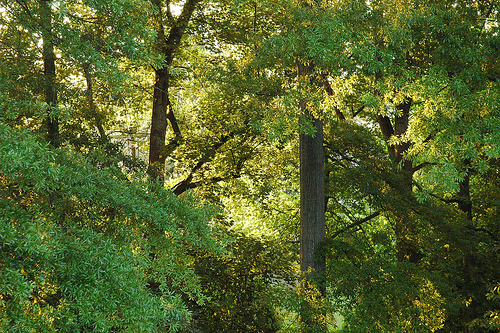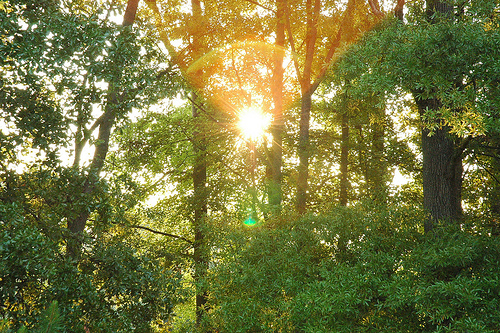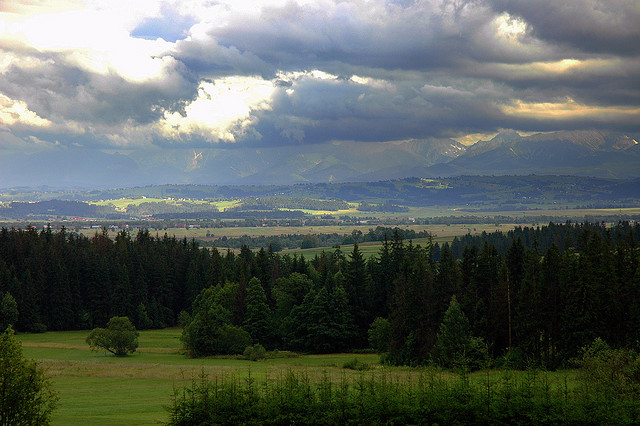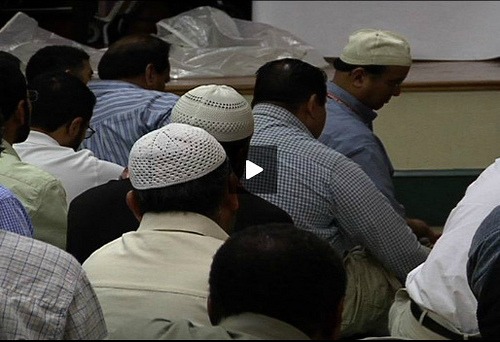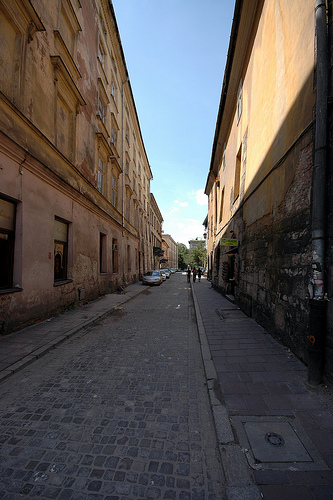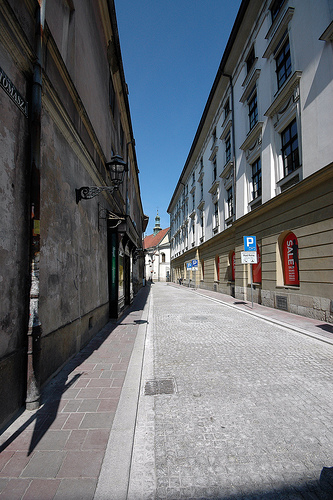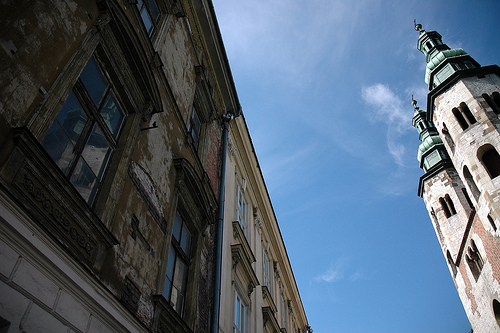Painting Oneself into a Corner
Much to many believers’ and atheists’ chagrin, there are few things in religion that could provide quantitative evidence about religion’s claims. Christianity does make one claim, though, that I think is quantifiable: the workings of the Holy Spirit.
It all began back on a first-century Pentecost:
When the day of Pentecost came, they were all together in one place. Suddenly a sound like the blowing of a violent wind came from heaven and filled the whole house where they were sitting. They saw what seemed to be tongues of fire that separated and came to rest on each of them. All of them were filled with the Holy Spirit and began to speak in other tongues as the Spirit enabled them. (Acts 2.1-4)
Most Christians believe that through the power of the Holy Spirit, baptized believers are able to do things they wouldn’t otherwise be able to do. If you look at references to the Holy Spirit in the Bible, it generally seems to be providing peace and wisdom. The Holy Spirit is supposed to dwell within believers, making them new creations and such.
Wouldn’t that have an effect?
Take a country like Poland, where 97% of the population claims Catholicism as their religion, and I’d say closer to 99% have been baptized. If there was any truth to the claim that the Holy Spirit’s indwelling somehow makes a difference, it should show up statistically in a country where 99% of its inhabitants experience that “indwelling.” The crime rate should be lower; corruption should be rarer; evidence of love for fellow humans should be abundant. But that’s not the case. Indeed, the crime rate in Poland is just about the same as any other country in Europe; corruption in Polish politics exceeds the level of other European countries; and Poles clearly show love of fellow humans about as often as any other group of people (read: not very).
Apologists would claim that there are many other factors at work here and rightly point out that there is an element of free will in all humans. However, I’m not expecting the Holy Spirit to create a paradise; I’d be satisfied to see some small statistical difference.
Lipnica Wielka
The village where I spent seven years of my life.
K held the camera as we drove to visit friends. Silly, but I’m sentimental, so it’s excusable. (It’s double-time so it doesn’t take so long, but of course it makes us all sound like chipmunks in the background. It also makes it jerky. Oh well…)
A Day at Gubalowka
We finally began putting together some of the video shot in Polska. First up: our day at Gubalowka, a ridge line above Zakopane that is basically one big playground. We took K’s five-and-a-half-year-old nephew, W, with us.
NYT Frugal Traveler
There’s a new video blog at the New York Times called the Frugal Traveler. Week 10 is a visit to Gdansk Poland.
Why Gdansk? Why not Krakow? Unlike both Gdansk and Warsaw, Krakow was not totally destroyed during the Second World War, and its old town is just that — old. Perhaps the choice of Gdansk came from week 9’s spot: Vilnius, Lithuania. It’s a shorter hop from Vilnius to Gdansk than Vilnius to Krakow.
Still, it’s good to see Poland getting included like this.
A Walk in the Park
Aunt L is visiting, so we took her to the park downtown.
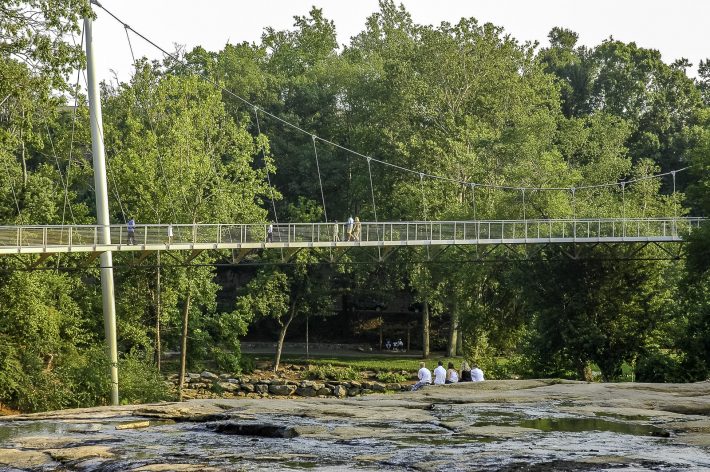
It was surprisingly empty for a Sunday afternoon. There were small groups here and there, but I guess the heat was keeping most people in.
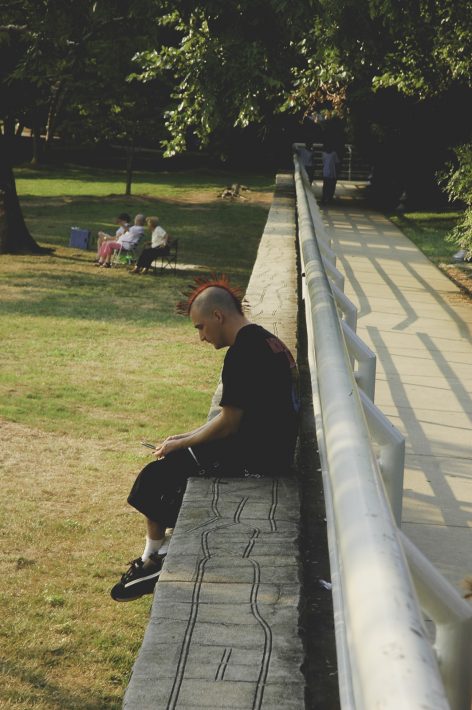
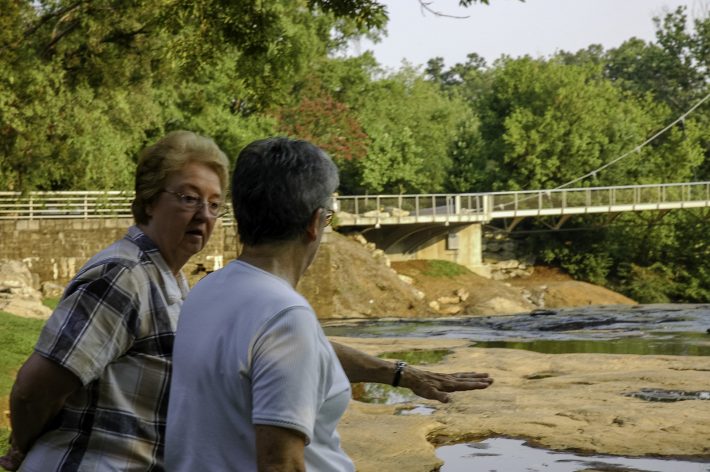
The Girl had a blast, especially with the ducks. They bonded, and it was a tearful goodbye.
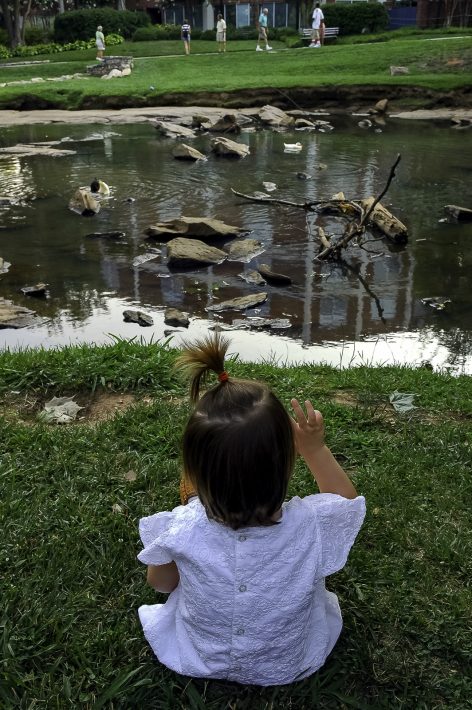
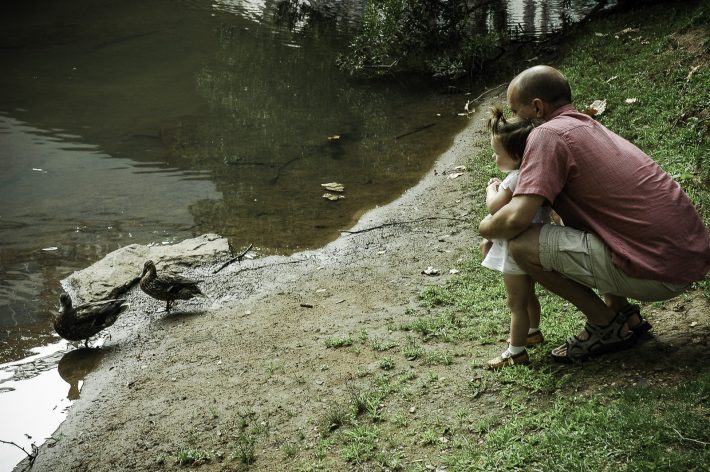
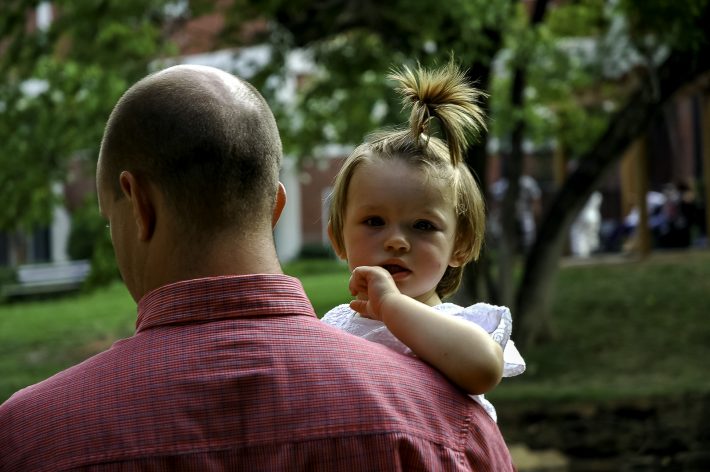
She’s learned what ducks say, and she was thrilled to get independent confirmation that what K and I told her about duck communication was accurate.
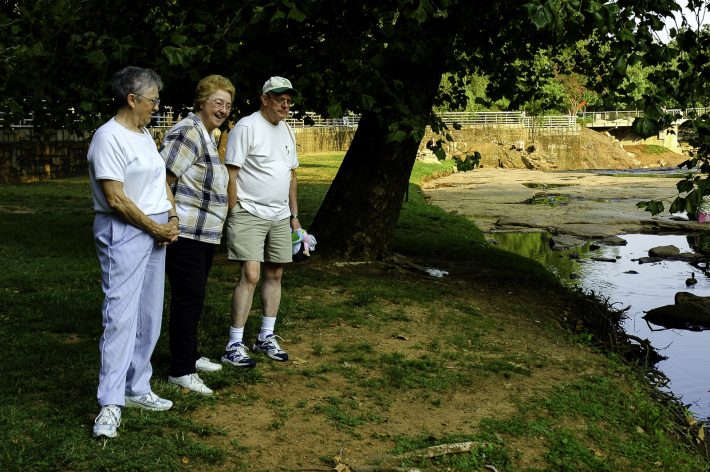
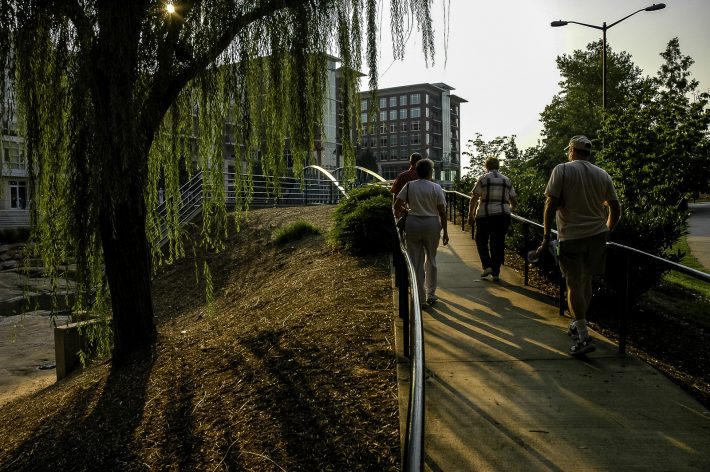
Morning Sun
Storm
You’ve Been Left Behind
When Jason received the email, he was panicked. He’d heard his father talking about the rapture for all his life, but he’d never really bought into it himself. Then, suddenly, an email from dad:
Dear Jason,
You must be wondering what happened to me, and I’m sure you’ve noticed that I’m not the only one to disappear. I’m also certain that you’re well aware of what has happened. And sadly, I’m sure you understand why you’re still here, left behind.
I have arranged to have this email sent so that I might have one last word with you, one last plea for you to take a look in your heart and see how much you really need Jesus as your Lord and Savior. There can be no doubt in your mind about the troubling times that are looming now that the rapture is history, but those troubles are nothing compared to what you will face if you don’t fall to your knees and pray this simple prayer.
Lord Jesus, I am a sinner. But I believe that you died upon the cross for me. That you shed your precious blood for the forgiveness of my sin. And I believe that on the third day, you rose from the dead, and went to Heaven to prepare a place for me. I accept you now as my Savior, my Lord, my God, my friend. Come into my heart, Lord Jesus, and set me free from my sin. And, because you are my Savior, Jesus, “I shall not die, but have everlasting life”. Thank you Jesus!
Please, son: do this for your own soul’s sake!
Jason sat stupefied for a moment, wondering whether or not he’d been wrong all this time about his father’s “silly religious rantings.” It seemed that he was wrong, and he was about to get down on his knees when the phone rang.
“Hi son,” said the familiar voice.
“Dad? I thought, I mean, the email, the rapture — I thought you were gone!” Jason stammered, on the verge of tears.
“Oh, did it get sent. God damn it, those people assured me there was no chance of an accidental, pre-rapture sending of all those emails. You know, son, you just can’t trust anyone these days, not even Christians. Or so-called Christians.”
What torment it will be for those caught up in the Rapture to spend the Tribulation with Christ yet knowing some of their loved ones didn’t make it. Wouldn’t it be a great relief if these poor, tortured, saved souls could have one last shot at reaching their loved ones for Christ?
There is Hope: youvebeenleftbehind.com.
Their service is simple: for a low yearly fee, they’ll save documents for you that will be emailed after the rapture.
We have set up a system to send documents by the email, to the addresses you provide, 6 days after the “Rapture” of the Church. This occurs when 3 of our 5 team members scattered around the U.S fail to log in over a 3 day period. Another 3 days are given to fail safe any false triggering of the system. (You’ve Been Left Behind )
How about a stack of letters on your desk? Wouldn’t that accomplish the same thing without the risks involved (i.e., storing significant amounts private data on a server)?
And that’s not the only risk. Emails accidentally sent could, theoretically, be amusing, but it could also damage relationships. Imagine someone gets one of these “You’ve been left behind” emails from a close family member yet she always considered herself a prime rapture candidate. Can’t you hear the heated phone call?
“You mean all this time you’ve thought I wasn’t saved? How dare you judge me like that!”
I told my Polish Catholic wife about it, first explaining what the rapture was — there are not many Polish Catholics who know what the rapture is, let alone the difference between pre-trib and post-trib and mid-trib and late-trib and early-trib and all the other -trib varieties out there. Her response: “Only in America!”
Plurality
A Wista
We got a bit of new music during our trip and I’ll be sharing a little here and there during the coming weeks. Sadly, much of it probably won’t be available in the States.
Once upon a time, there was a Polish folk band called “A Wista.” Comprised of highland students who’d landed in Krakow for studies, the band played a mix Slovakian, Moravian, Balkan, and Hungarian songs, along with traditional Polish songs from the southern, mountainous region of the country.
Their studies long completed, they’ve since gone their separate ways, though K and I have a connection to three of the band members.
- One is the husband of K’s good, better, bestest friend.
- Another, with a newly formed band, played at our wedding.
- A third, with K’s friend’s husband and two others, played at L’s baptism.
It’s a shame they’re no longer together, for their music is truly beautiful: virtuoso playing (violin, viola, and double bass) combined with strong singing.
Here is my favorite from their CD Festiwal Karpat: a haunting Slovakian number:
Anyone interested can buy individual MP3s of the album here.
For fun, here’s the Google translation of the page. The genre in the original Polish is listed as “Ludowa” (“folk”), but Google chose the equally valid translation of “China”.
George Carlin on Corporate America
“It’s called the ‘American Dream’ because…”
Apologies about the language for those with sensitive ears, but there’s more truth in these four minutes than I’ve heard from the traditional media in years.
Narrow Streets
Looking Back at Krakow
We made it home yesterday after an exhausting journey. L fell into fits of hysterical screaming on the flight from Munich to Charlotte, and there was mumbling about the plane regarding it — as well as a few comments swirling around our heads while we stood in the passport control line. The temptation to say something was great, but I decided to keep it a win-lose situation (i.e., we win, acting like adults; they lose, acting like children) instead of descending into a useless argument, for there was no win-win situation in sight as tired as we all were.
The trip was exhausting, but we had wonderful memories to keep up our spirits, including two days in the most magnificant (and second most expensive) city in Polska, Krakow.
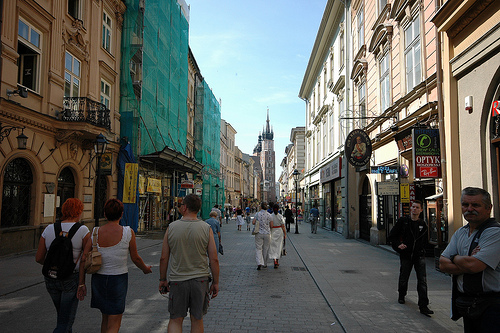
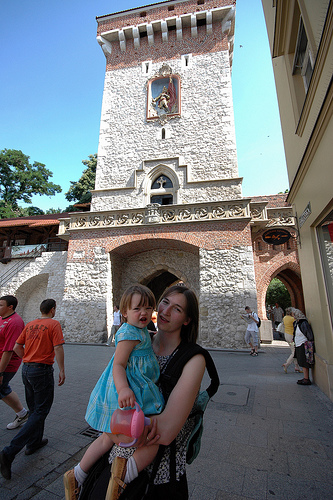
The first thing we noticed, coming by bus, was the new shopping center cum bus stop. When we left in 2005, it looked like this:
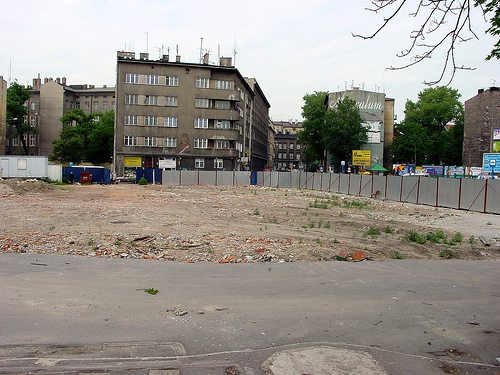
Three years — and a surprising amount of initiative — later:
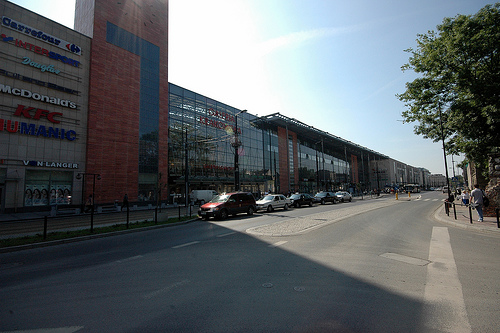
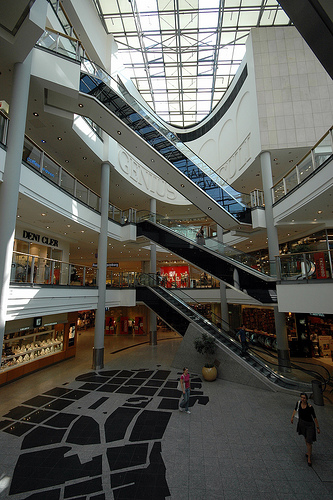
The old bus station was a testament to the hideous nature of Communist architecture, and it was torn down before I even knew it had been slated for demolition. “Oh, what I wouldn’t give for a couple of hours in that old place now,” I told K.
Also victim of the renovation was the “Dragon Bar” (“Bar Smok”), a milk bar across the street from the old bus station. Filthy does not begin to describe it, and once again, I find myself wishing for a 4gb memory card and a day to photograph it.
As we made our way to the rynek, we noted that some things had mercifully not changed. The opera house still greets visitors after they emerge from the passage under Westerplatte Street.
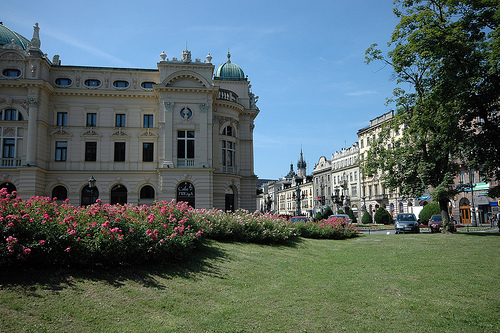
And the corner of Pijarska and Planty streets still looks the same:
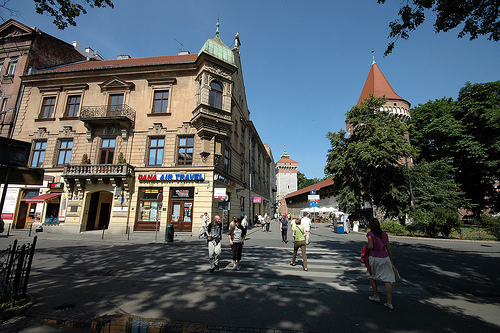
We finally made it to the rynek, where L seemed just as amazed as everyone else is they first time they emerge from Florianska Street onto Krakow’s enormous square:
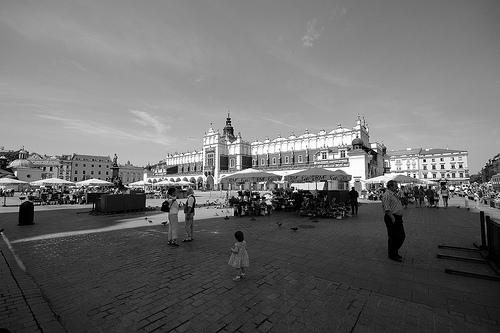
We fed the pigeons,
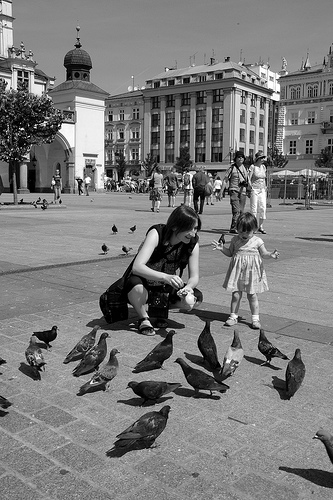
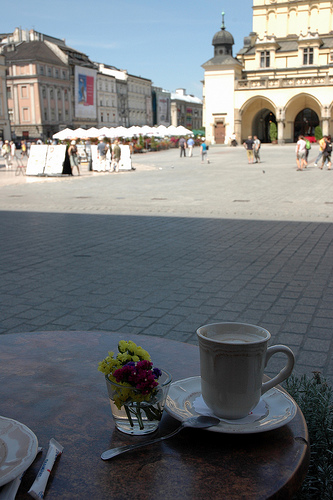
and watched the people around us. Some were trying to get the best shots with classic Russian equipment:
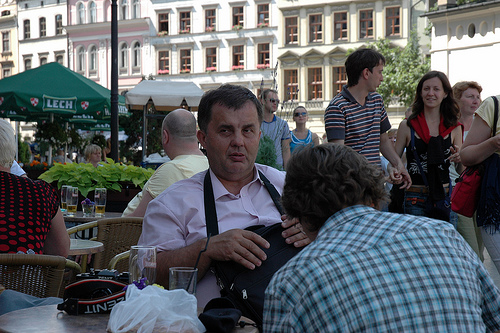
Some were simply passing through:
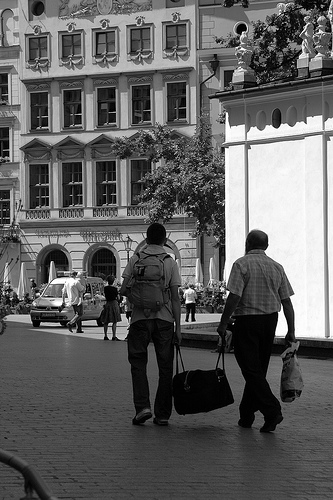
After a short break, we headed inside the Basilica of St. Mary — what I’d bought the 10-20mm for:
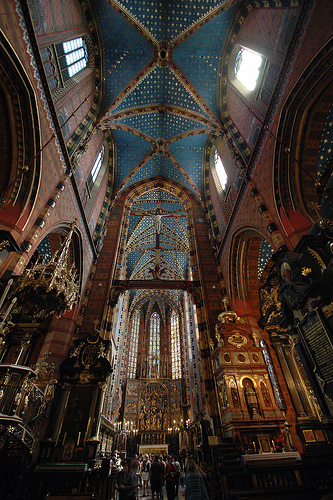
I’d brought a tripod in order to try to get some shots to combine into HDR, but I was kindly informed during my final shot of my first series that tripods were not allowed.
I’m always amazed with the beauty of such places.
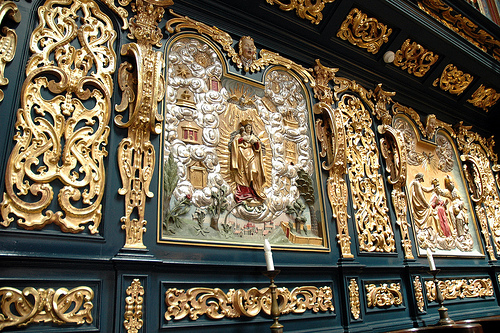
And I’m glad the Church so wisely followed Jesus’ command to feed the starving, clothe the poor, and build ridiculously big churches.
We headed down Grodzka Street toward Wawel castle
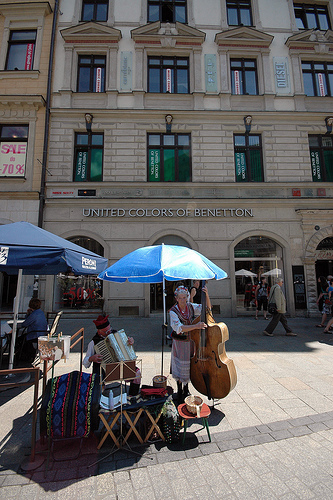
Finally, exhausted, we fell into a cafe for some rest, respite from the sun (L was fussy and sweaty), and, most importantly, a chance to meet up with some of our dearest friends, Kuba and Maja:
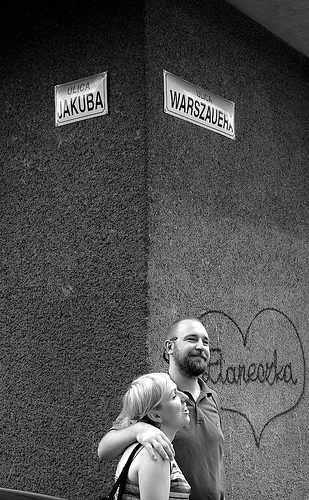
We spent our last New Year’s Eve in Polska with K & M in Hel, a little port town at the tip of a long finger of land into the Baltic Sea.
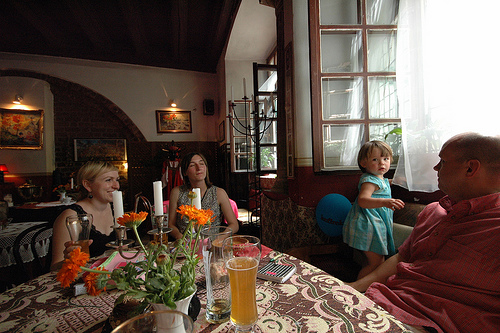
Maja — the “maja” of comments here — has been eager to meet the girl for some time, and they hit it off immediately:
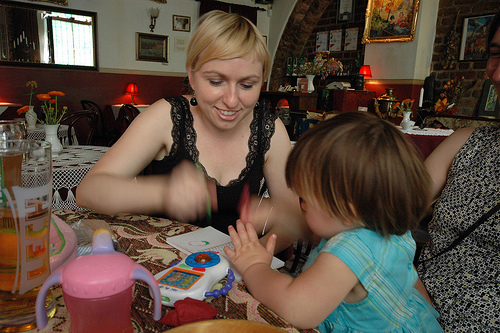
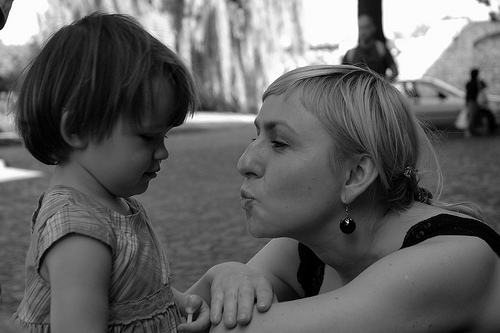
The initial excitement of our reunion finally calmed (M was bouncing off the walls with joy!), we all continued down Grodzka Street
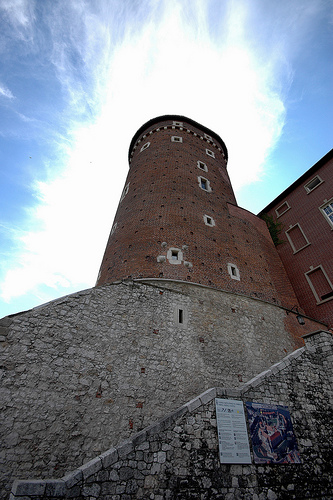
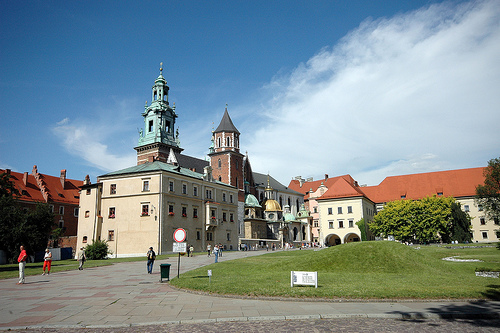
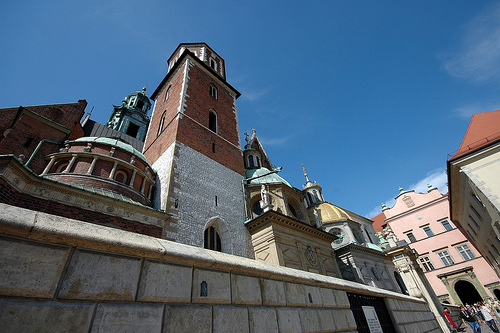
Finally, the Girl had had enough, and so we headed out of Krakow
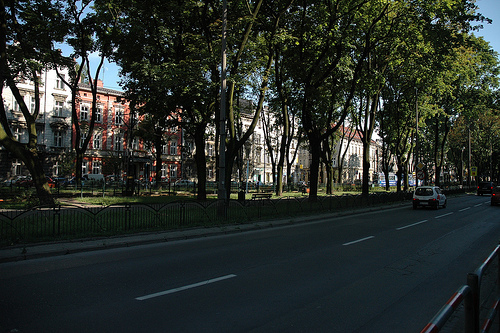
to a little town on the city’s outskirts, where K’s brother, D, lives.
We had grilled sausage to accompany a wonderful evening of reminiscing and talking about the “realities” of life in America.
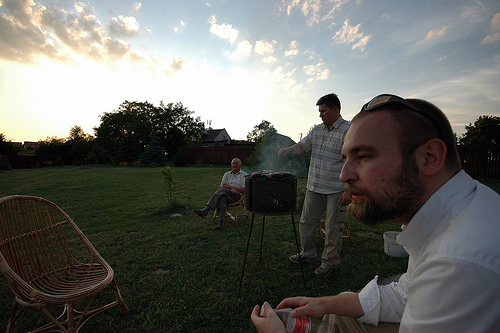
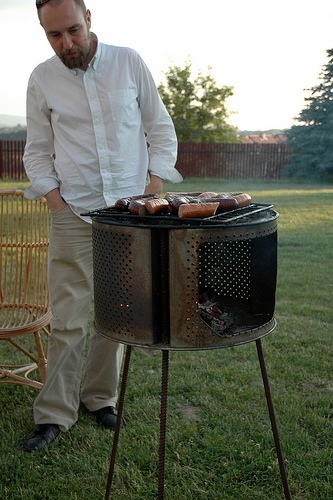
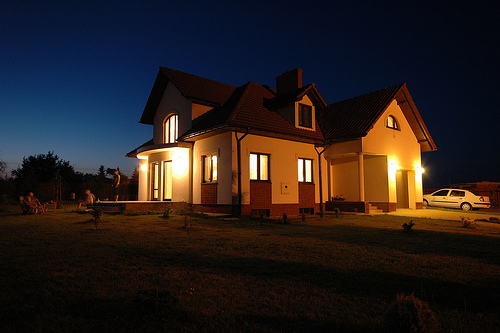
When D saw the wonders of a SLR camera’s bulb setting, he took me to a place to get some night shots of Krakow.
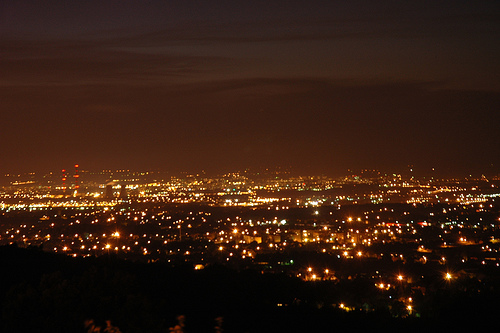
Sadly, there was too much light from the street lights to get good shots, but that fact did lead to this:
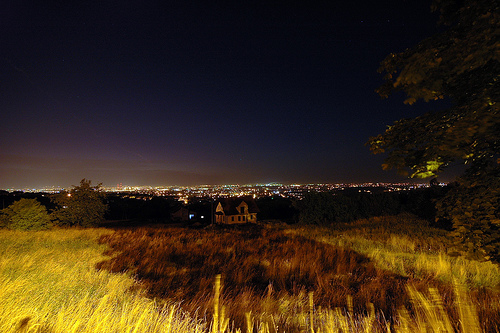
Thus ended our first day in Krakow.
Our second day was much slower and shorter. It included a walk in the park surrounding the old town,
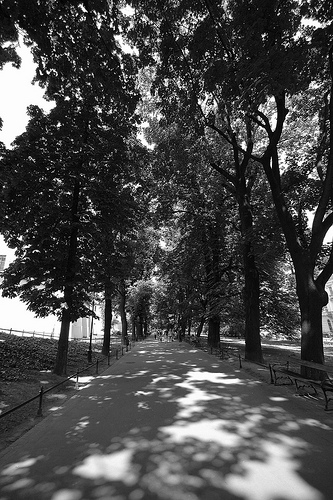
and K taking a few more shots.
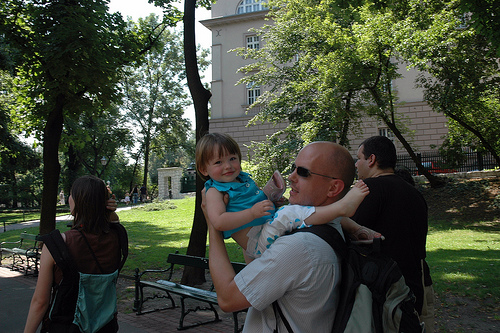
It ended in the old Jewish section of town, at an outside cafe, where still more friends came to meet us.
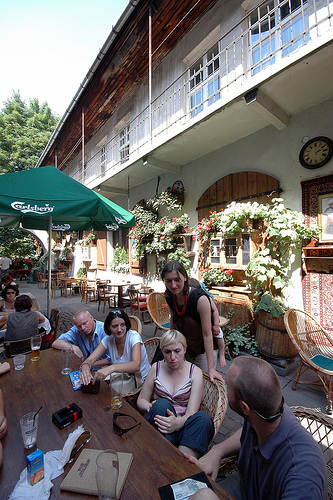
And thus our not-quite-two weeks in Polska came to an end.
More reflections — not to mention pictures — later.
The Challenge
Hugh Nibley wrote an article in which he described an “assignment” professors at Brigham Young University like to give students who are taking the required course on the Book of Mormon.
Since Joseph Smith was younger than most of you and not nearly so experienced or well-educated as any of you at the time he copyrighted the Book of Mormon, it should not be too much to ask you to hand in by the end of the semester (which will give you more time than he had) a paper of, say, five to six hundred pages in length. Call it a sacred book if you will, and give it the form of a history. Tell of a community of wandering Jews in ancient times; have all sorts of characters in your story, and involve them in all sorts of public and private vicissitudes; give them names–hundreds of them–pretending that they are real Hebrew and Egyptian names of circa 600 B.C.; be lavish with cultural and technical details–manners and customs, arts and industries, political and religious institutions, rites, and traditions, include long and complicated military and economic histories; have your narrative cover a thousand years without any large gaps; keep a number of interrelated local histories going at once; feel free to introduce religious controversy and philosophical discussion, but always in a plausible settings observe the appropriate literary conventions and explain the derivation and transmission of your varied historical materials. Above all, do not ever contradict yourself! For now we come to the really hard part of this little assignment. You and I know that you are making this all up–we have our little joke–but just the same you are going to be required to have your paper published when you finish it, not as fiction or romance, but as a true history! After you have handed it in you may make no changes in it (in this class we always use the first edition of the Book of Mormon); what is more, you are to invite any and all scholars to read and criticize your work freely, explaining to them that it is a sacred book on a par with the Bible. If they seem over-skeptical, you might tell them that you translated the book from original records by the aid of the Urim and Thummim–they will love that! Further to allay their misgivings, you might tell them that the original manuscript was on golden plates, and that you got the plates from an angel. Now go to work and good luck!
Nibley concludes,
To date no student has carried out this assignment, which, of course, was not meant seriously. But why not? If anybody could write the Book of Mormon, as we have been so often assured, it is high time that somebody, some devoted and learned minister of the gospel, let us say, performed the invaluable public service of showing the world that it can be done. (The Book of Mormon: True or False?)
I think Tolkien did something comparable with this Lord of the Rings. It fits most of the criteria:
- It’s 500-600 pages long — per volume.
- It’s very “lavish with cultural and technical details,” including “manners and customs, arts and industries, political and religious institutions, rites, and traditions, include long and complicated military and economic histories.”
- The narrative covers, indirectly, many centuries.
- There are names — hundreds of them.
- It involves “them in all sorts of public and private vicissitudes.”
There are two major differences. First, Tolkien didn’t make his story about a group of wandering Jews. Second, Tolkien didn’t pass his story off as sacred.
All of that to say it can be done.
Gubałówka
Last day in Orawa/Podhale. Tired Girl; semi-eager Cousin W. Only one thing to do — go to Gubałówka.
Up the inclined railway
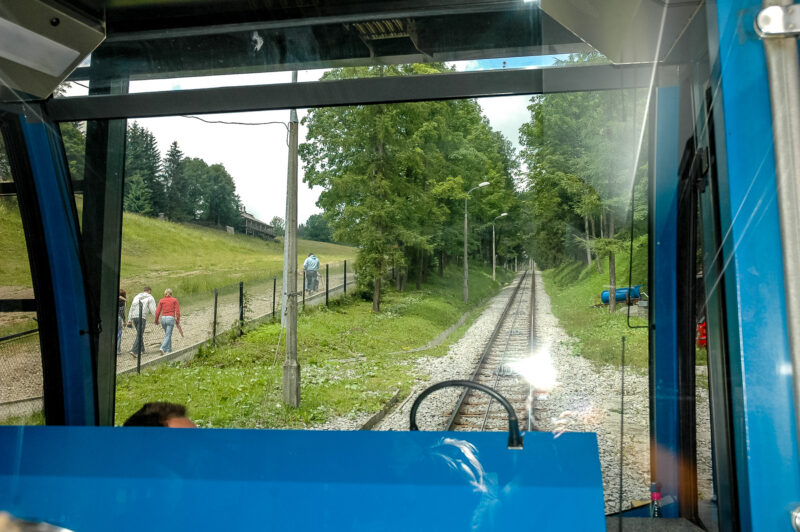
Down the metal bobsled-ish ride with Aunt K:
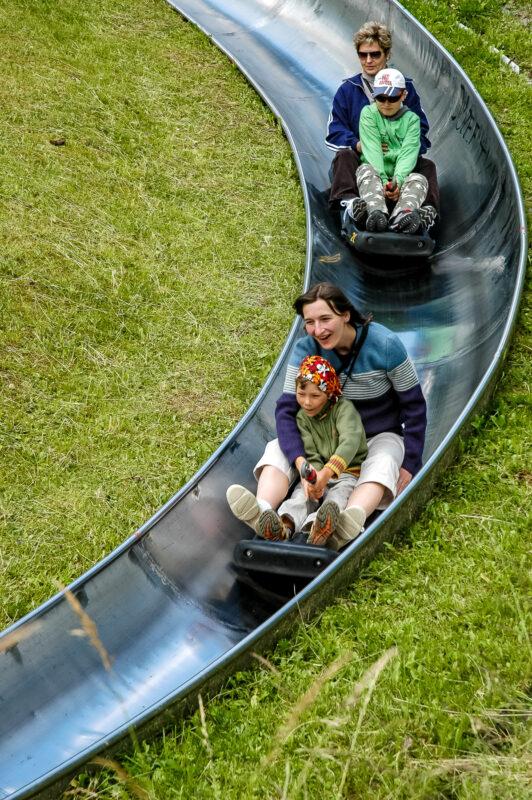
And then a bite to eat.
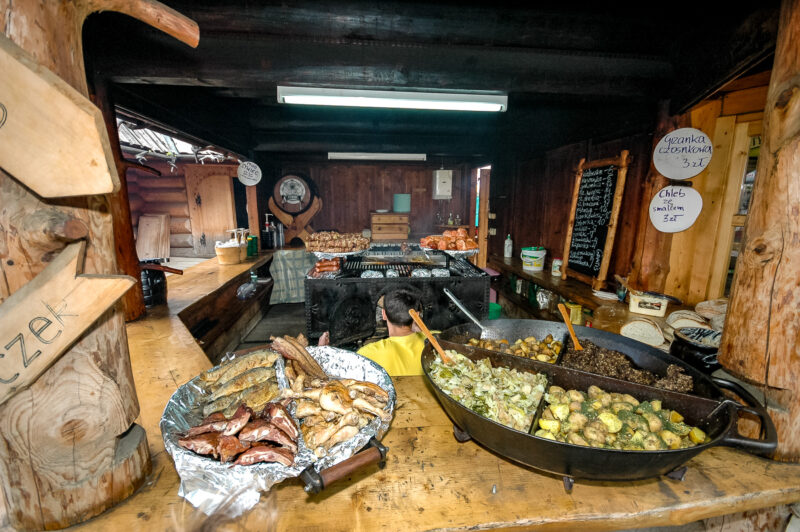
Cousin W had a crepe:
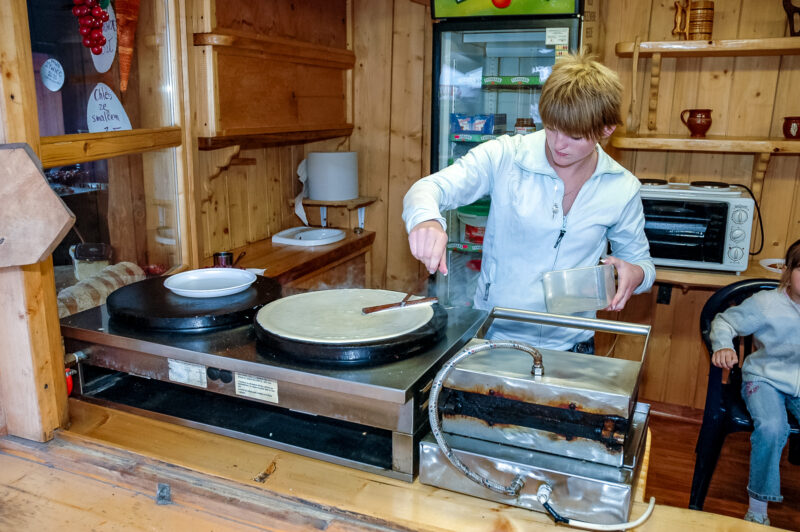
K and I shared potato pancakes with garlic sauce
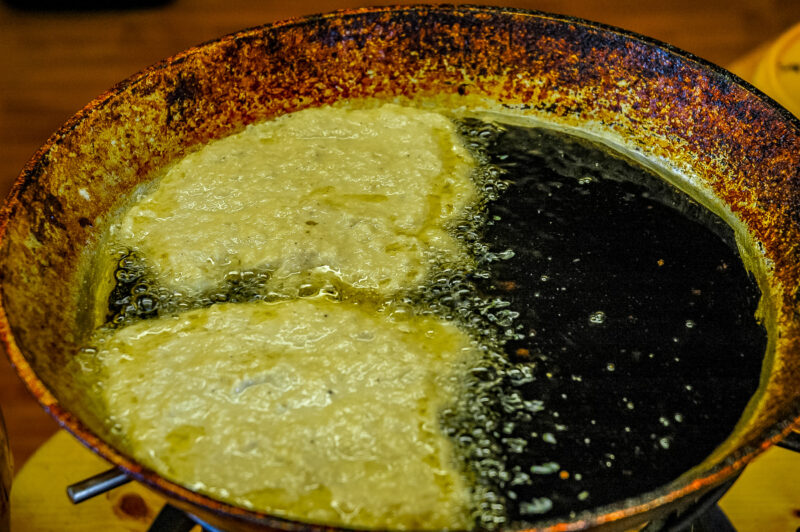
And something Poles will recognize but I will refrain from describing further:
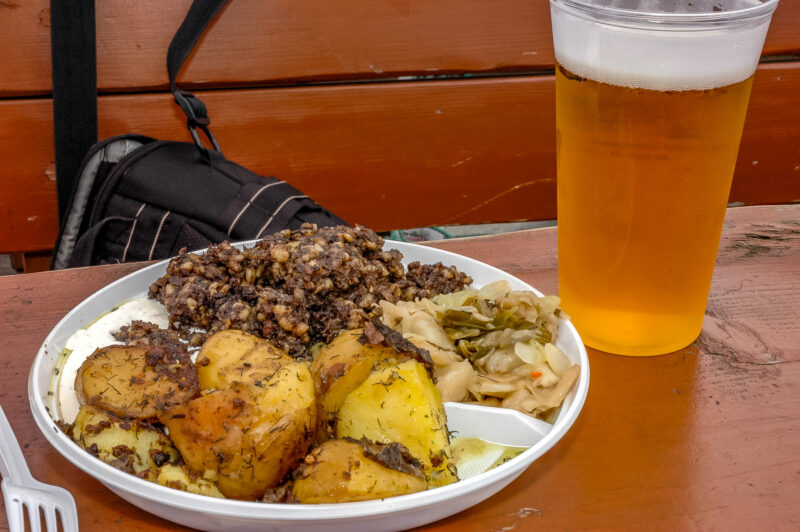
We went to the new “line park.”
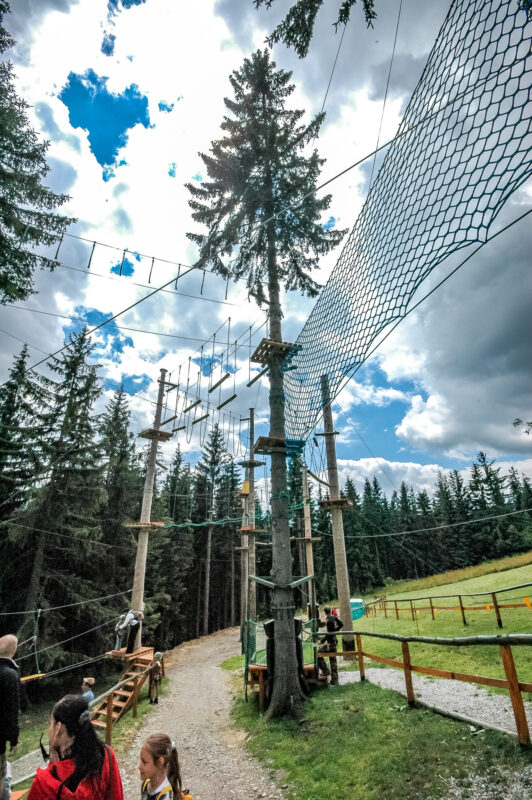
Cousin W had a blast on the kids’ zip line.
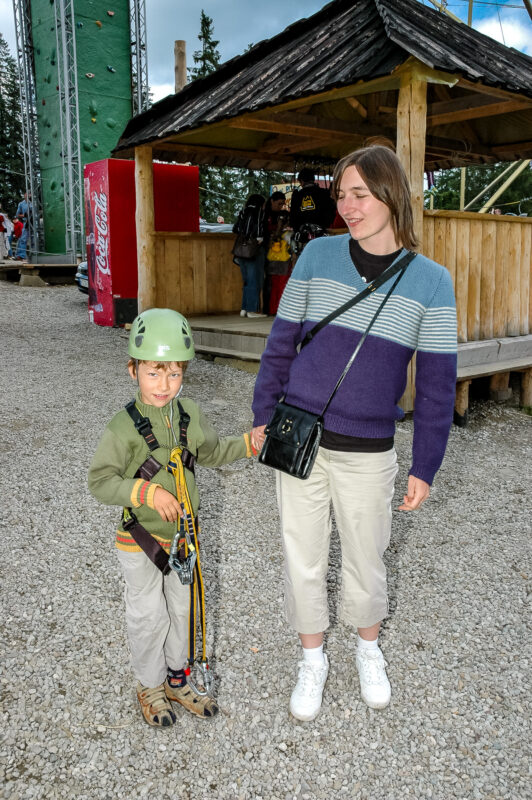

Then a pony ride,
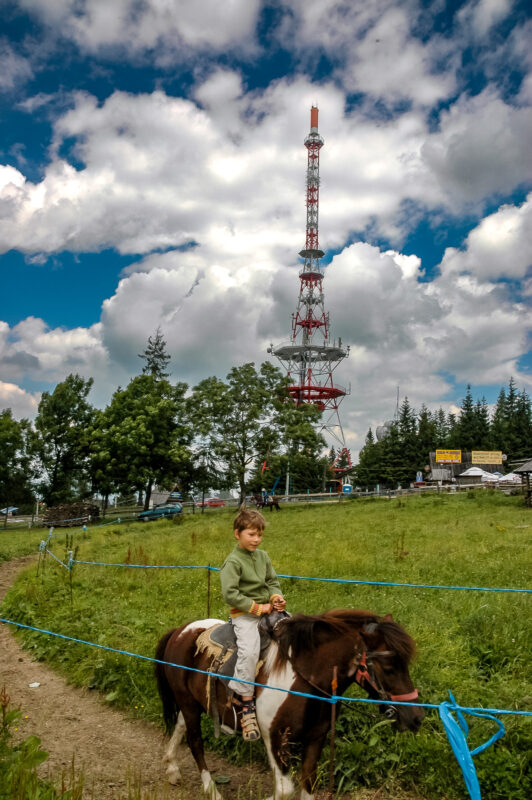
a group portrait,
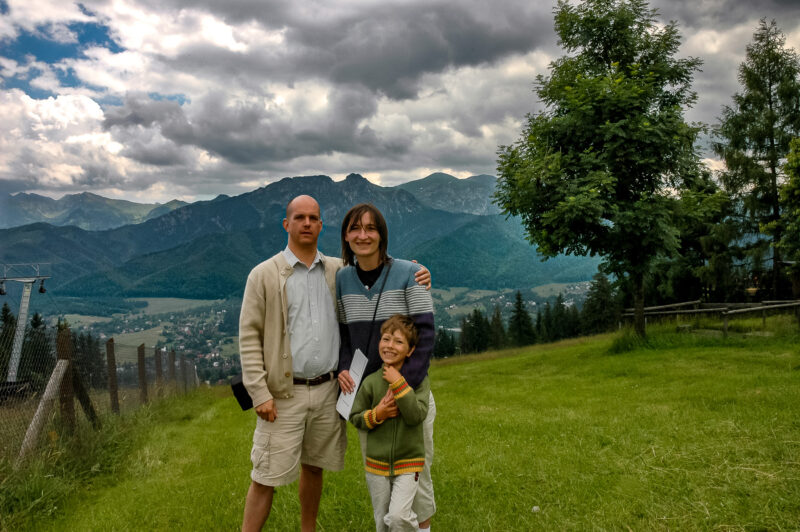
and a return to a young lady very happy to see her mother.
Tooth
Today we visited Aunt Z in Zab (Tooth) — the highest village in Polska.
A few minutes’ walk from Aunt Z’s and this is the view:
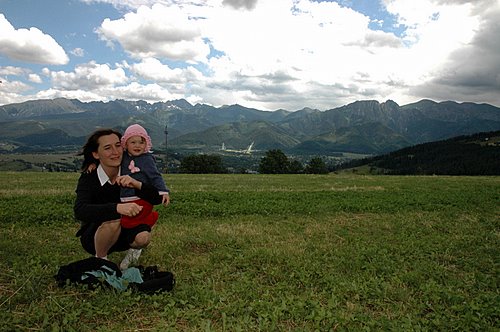
A storm came in quickly:
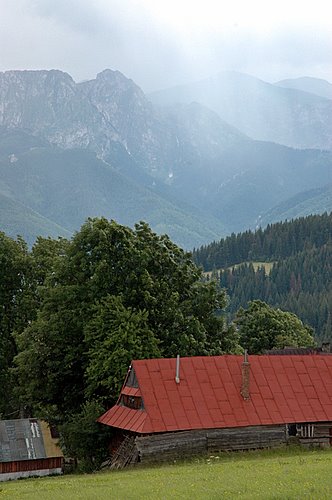
It passed and I took a walk in Aunt Z’s back yard:
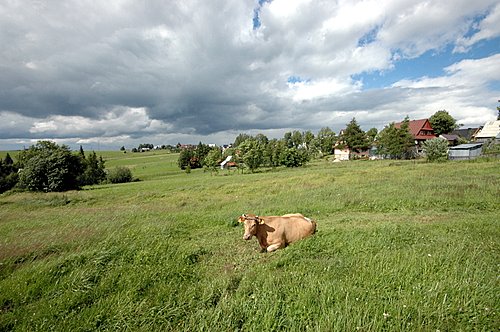
Despite all this — the beauty, the storm, the intensity of the views — people continued working as if nothing were out of the ordinary.
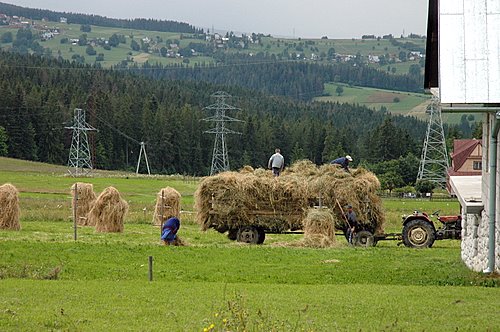
And as much as I would like to write more and add more pictures, the family awaits downstairs.
There might not be another update until Monday. We’ll see.
Now, I have more important things to do, and you do, too. Go find them!
A Walk in a Valley
We could have easily come to southern Poland and not crossed the border into Slovakia and no Pole would say a thing. However, to spend two weeks within 45 kilometers of Zakopane and not spend a day there?! A shame — no, a sin!
Well, truth be told, Zakopane is packed, packed, packed with tourists, and it’s more like a trip to Gatlinburg than anything else. Still, it’s Polish Gatlinburg, and that makes all the difference.
We began our day with a walk in Stzazyska Valley. We left little Cousin S behind because she doesn’t like to walk so much as she likes to be pushed about in her carriage, and not having another Ergocarrier, it seemed like a potential disaster to have both of them with us.
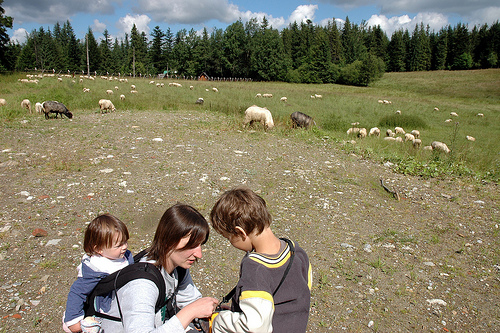
We didn’t get very far before we pulled out the camera. Next to our parking was a herd of sheep. L was so excited she could really hardly stand it.
After a few minutes with the sheep, we finally made it to the trail. It didn’t take long for the views to be come awe-inspiring.
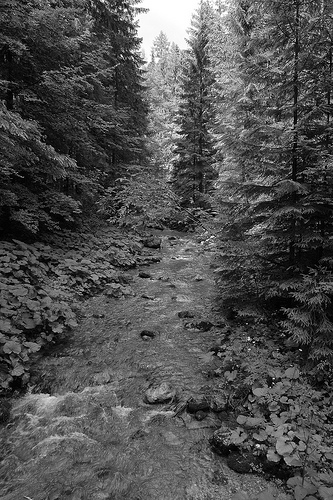
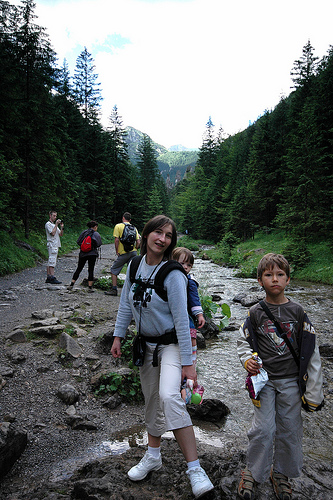
This particular valley leads to the base of Giewont, the Sleeping Knight. Legend has it that, in times of national trouble, the knight awakens and defends the homeland.
“Slept well through September of ’39,” I laughed. “Oh, it’s just a legend,” K replied, spoiling a perfectly good joke.
Quickly enough, we made it to the base, where the slacker knight is clearly visible.
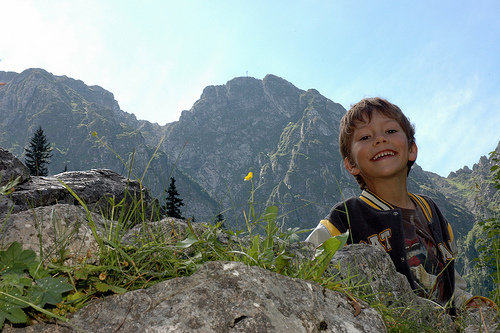
Well, clearly visible if you know what you’re looking for. Perhaps a more conspicuous knight would have been a more effective prophylactic, but that’s neither here nor there.
If you look at the picture, you’ll see a small cross at the top of the mountain. That’s supposed to be his upper lip. To the right of that is an enormous nose — given the antisemitism of Poland and the accompanying Jewish stereotypes, I’m surprised it’s not called the Sleeping Jew. None the less, you’ll find the knights eyebrow just to the right of the nose. Come to think of it, the Sleeping Marx Brother might be the most accurate name.
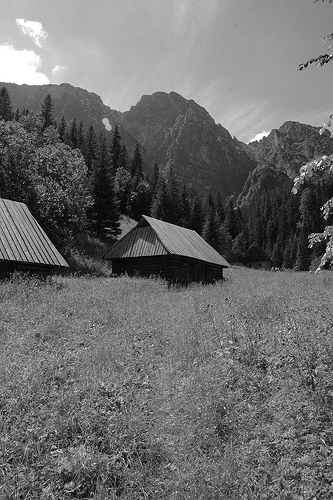
We took the opportunity to take a break and relax a moment while sipping instant coffee (5 zloty) and tea (5 zloty — regular, not instant), while Older Cousin W had a Sprite (5 zloty — noticing a pattern?).
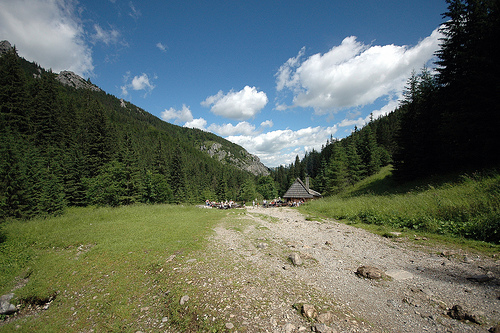
Then again, given the fact that things seem to be delivered by horse here might explain the cost. Might.
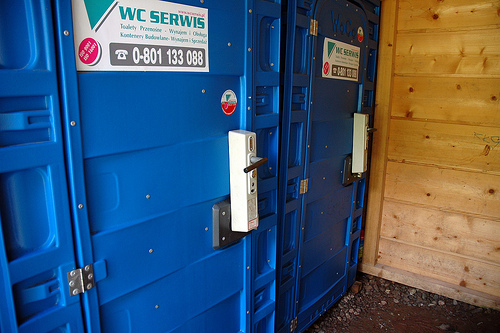
A quick bathroom stop reminded us that we’re in Poland. We paid 20+ zloty for snacks, but we still had to pay a blasted zloty for the bathroom.
“Do you have a zloty?” I asked K when she said she wanted to go to the restroom.
“You have to pay?” she asked.
“Of course we have to pay! We’re in Poland!” I said, loudly. In Polish. No one said anything.
I guess that’s not much of a converstion starter.
After our break, we began the final 10 minutes to our ultimate destination.
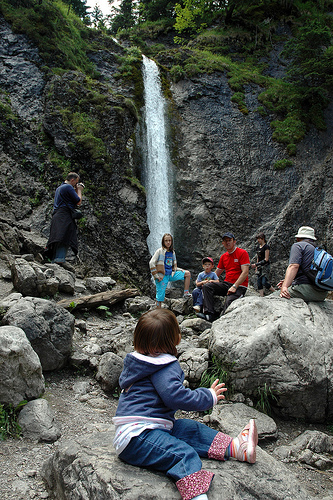
It was impossible to get L to turn around for a picture. Why look at a big stupid camera when you can look at this?
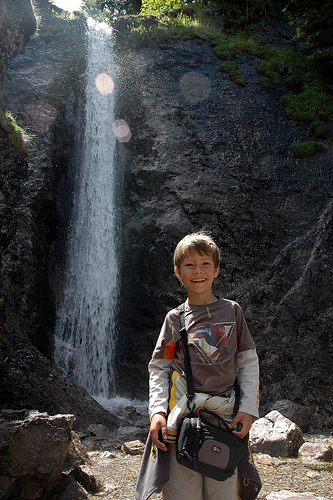
After L had climbed on every rock we’d allowed her (and then back down, and then back up, and then back down, and then back up), we decided we’d better head back or start looking for suitable lodging…
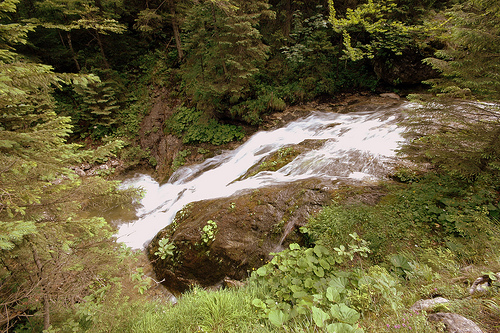
We stopped at the bottom of the trail for a bite to eat and yet another reminder of where we are:
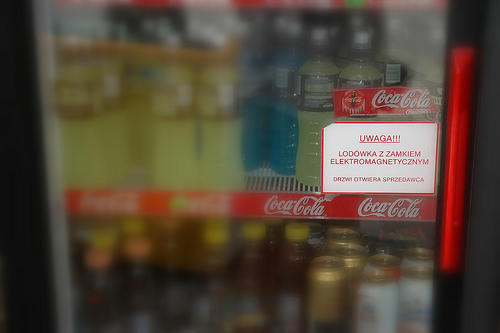
Poles in the States often comment on how relatively little minor thievery there is in the States. A good example (though not in the States) was in Budapest at the biker camp at which K and I stayed. There was a huge refrigerator filled with soda, beer, juice, and water, with a clipboard beside the fridge. The honor system: write down how many of what you take and pay when you check out. K was shocked. “Do you know how many people would pay in Poland?!” she asked.
Even Dziadek noticed and commented on that in America. Things that would have been chained to something — anything — immobile in Poland were sitting seemingly out in the open in the States.
This refrigerator was just outside the door of the little kiosk, yet locked. I’d wager that in the States it wouldn’t be. Then again, in the States it also wouldn’t have beer next to Coke.
After tanking up, we made our way to Zakopane, parking in the main lot under two bridges and making our way through the market — also under two bridges.
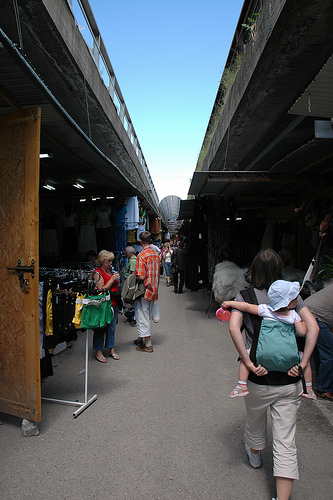
It’s a market where you can buy literally freshly-woven (if there is such a thing) socks.
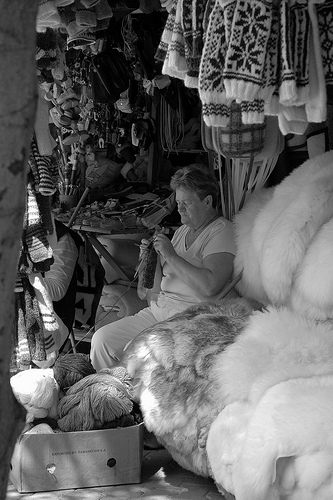
Or buy relatively-ridiculously cheap hand-crocheted table coverings from the craftswoman herself.
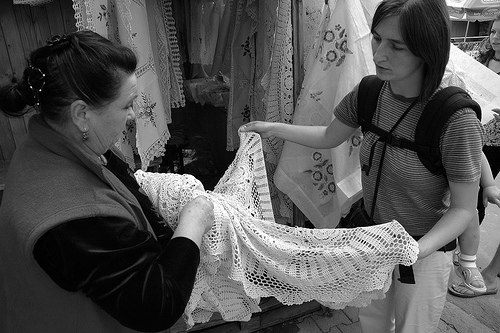
They say Poland is getting too expensive for Americans, and it is. The zloty now trades at 2:1 was opposed to the 4.5:1 it used to. Beer no longer costs 75 cents but instead two dollars. Still, we more or less stole this from the woman; she gave it to us for so few groszy. (Or, to be more correct, “groszych”.)
And what would the market in Zakopane be without a cheesemonger? On every corner.
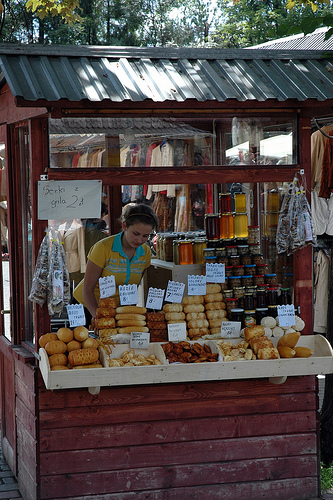
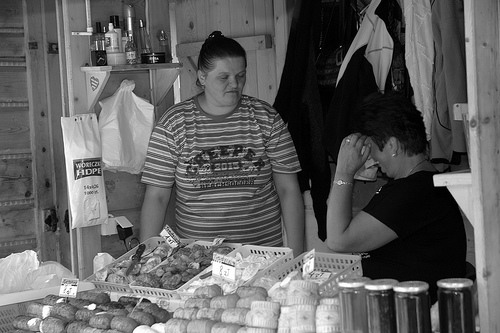
Not to mention wooden-toys-leather-hats-cheap-plastic-goods-mongers.
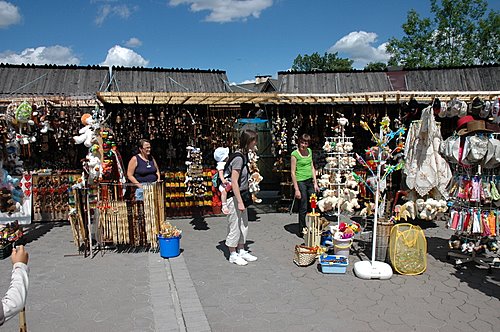
There’s a monger for everything here.
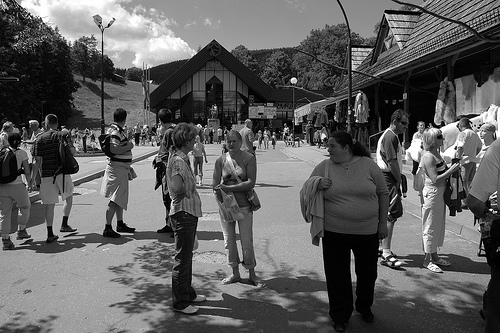
These ladies were ticket mongers. Scalpers, in other words. The large building behind them is the loading ramp for an inclined railway to Golbolowka — we’ll be going there Wednesday. They were offering “no-wait” tickets. And the one in the middle disappeared quickly when I began taking pictures.
Odd.
Next stop: Cmentarz Na Paskowym Wierzchu (Cemetery on Paskowy Wierzch), final resting place of more famous former-Podhale residents than you can shake a gofr at.
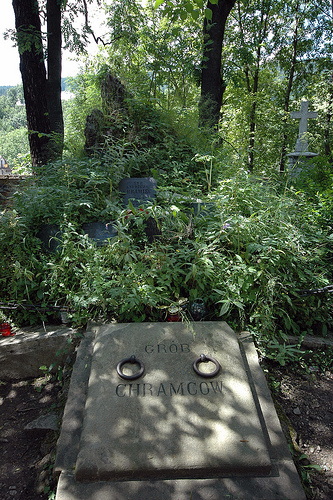
Not to mention a few unusual gravestones.
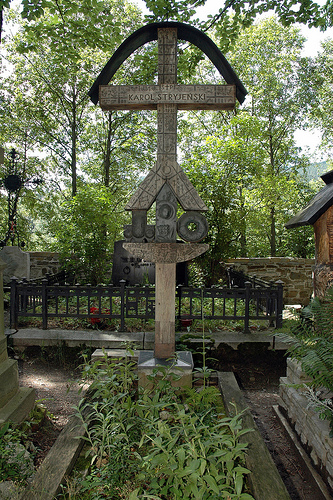
We wondered around a bit, pondered our mortality amidst the cries and whines of tired children, then decided it was time for gofry.
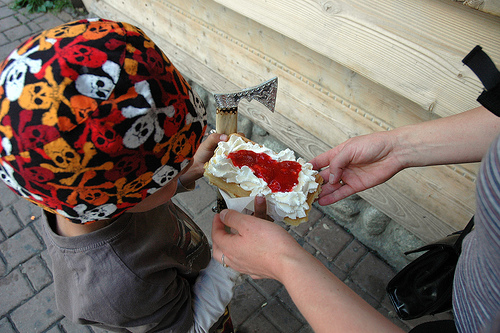
Yeah, it’s just a waffle with whipped cream and strawberry sauce — as if you can append “just” to anything with real whipped cream and tangy-sweet strawberry sauce.
We weren’t the only ones enjoying a sweet afternoon.
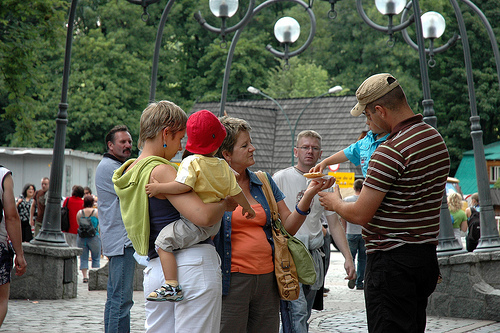
“This place is the best place in all Podhale for gofry,” K declared.
We finally found some refrigerator magnets — a habit Dziadek got us into during his visit.
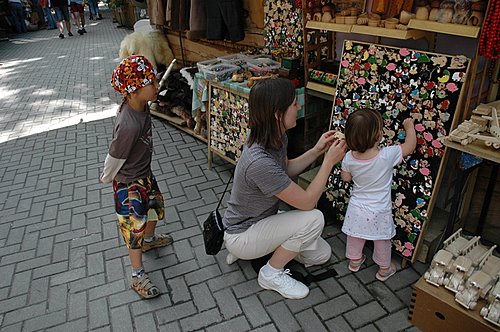
And K and the kids had their picture taken with the man with the easiest job in all Poland. Get dressed up like an old, bronze statue and move only when someone drops a coin in the can in front of you.
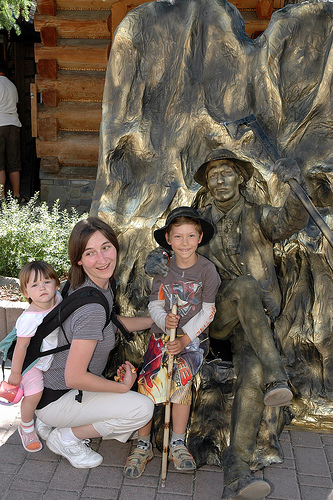
Slovakia
Technically, this post is a day late. And I should be talking about our amazing walk in the Tatra Mountains. But that’ll come tomorrow. In the meantime, Monday’s adventures.
We can’t come to southern Poland and not cross over into Slovakia. It’s beautiful, and cheaper.
First stop: Namestovo.
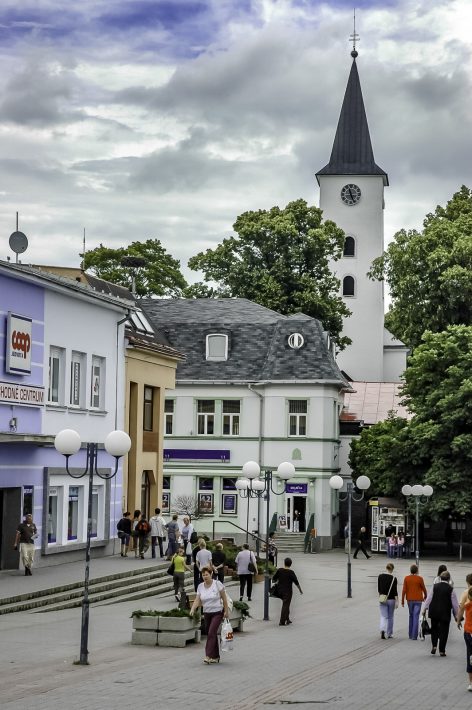
Namestovo is odd because it doesn’t really have a square as much as it has an L.
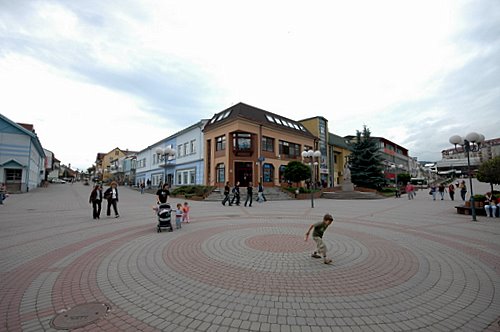
Slovaks, like many Europeans, think nothing of a beer with friends at 10:30 in the morning. I think it’s more common the further east one travels, but I do seem to remember reading about folks in Spain having brunch with a beer.
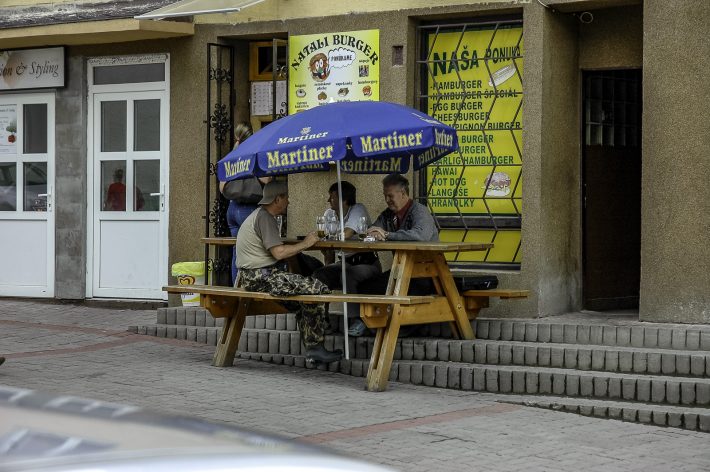
We walked around for just long enough for us all to be surprised that it was already 12:00. Lunch — and swings.
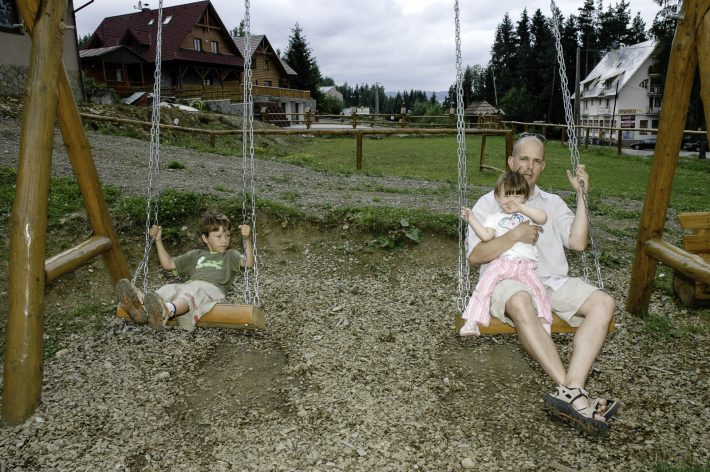
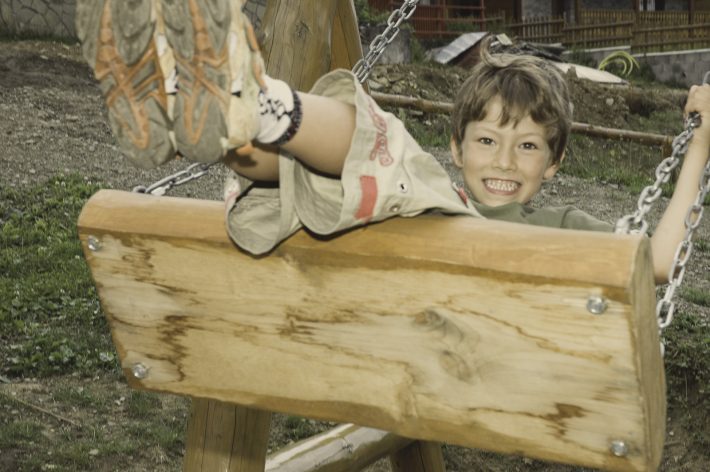
Everyone else was talking about what to eat — well, K was talking to the two kids who can express their desires verbally — but I knew from the moment we decided to spend the day in Slovakia: bryndzowe halusky.
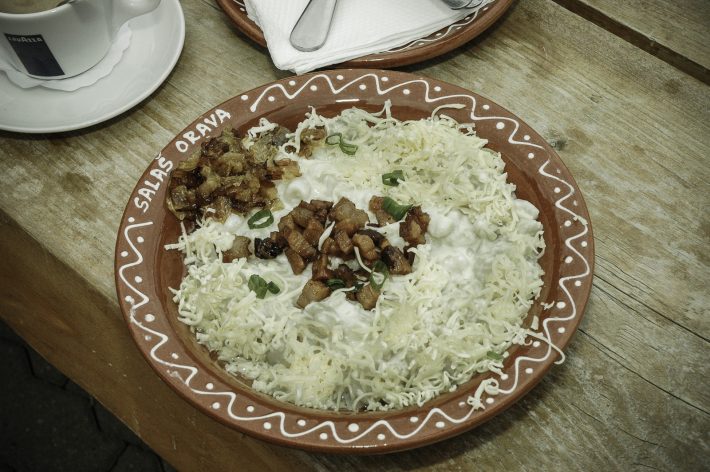
Basically, it’s dumplings in a creamy sauce, with this particular version having bacon bits and onions added. Smooth, tangy, creamy — I could eat a bucket of this stuff!
I’ve already told K that we’ll have to cross the border once more for a second helping!
Afterward, it was time to take the kids on a boat ride.
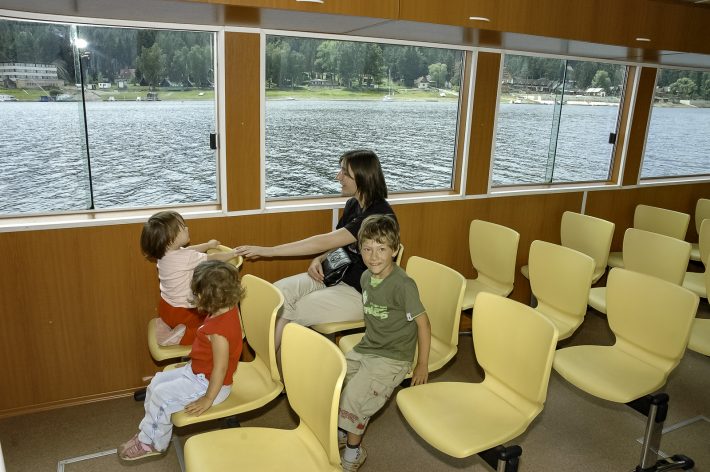
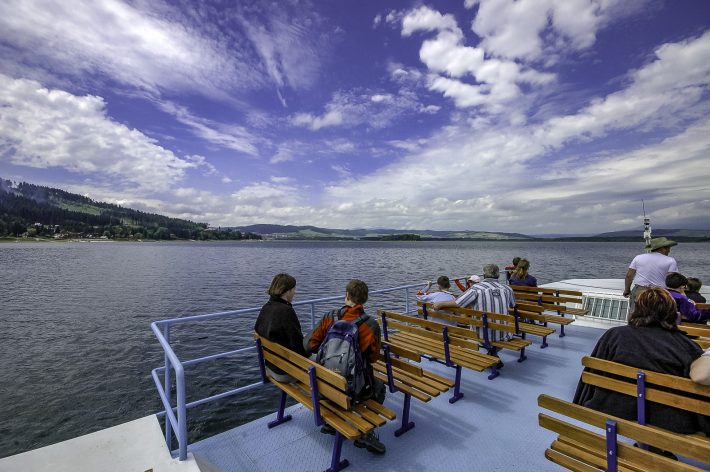
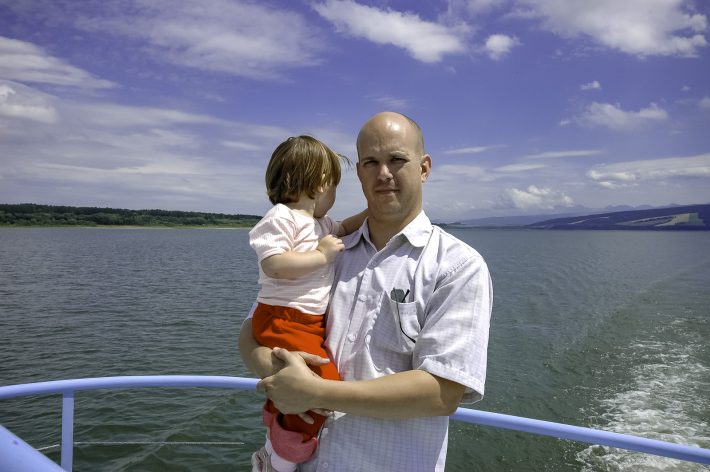
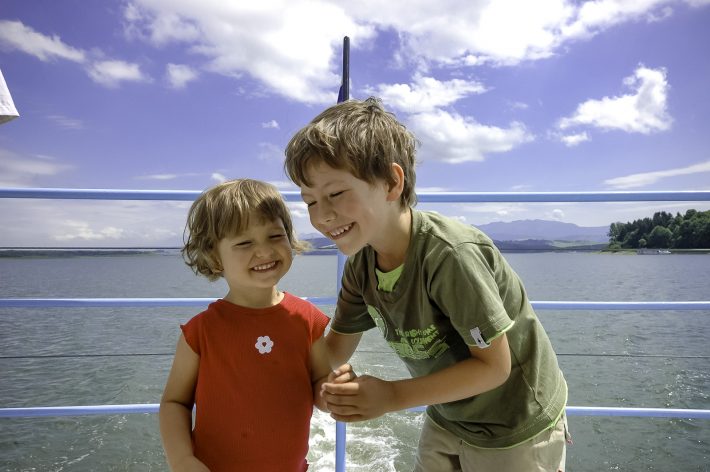
Lake Orawa is an artificial lake. Beneath its waters lie four villages.
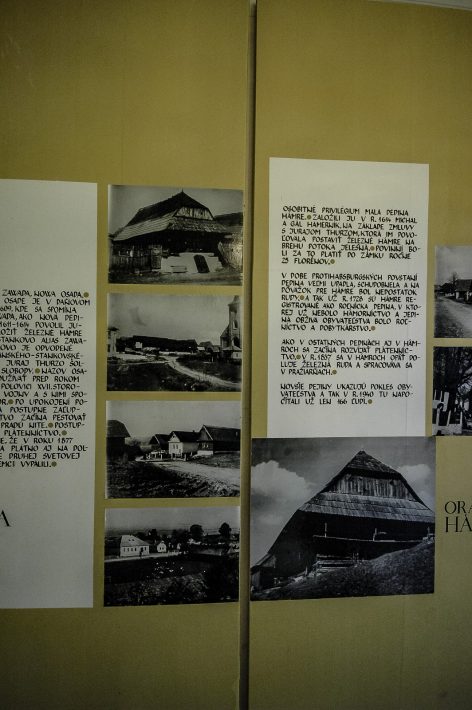
In the middle of the lake stands an island with the only surviving remnants of antediluvian Orawa.
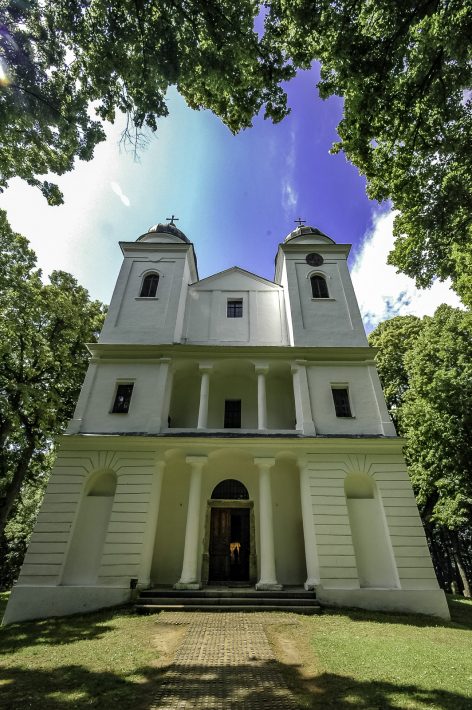
A surprisingly-large church that’s been converted to a museum. (We took Nana and Papa here, before they were “Nana” and “Papa”. It was a gloomy day in comparison.)
On the way back, we got a good look at Namestovo.
Odd — it’s now a lake-front town; pre-flood Namestovo would have been a mountain-top town.
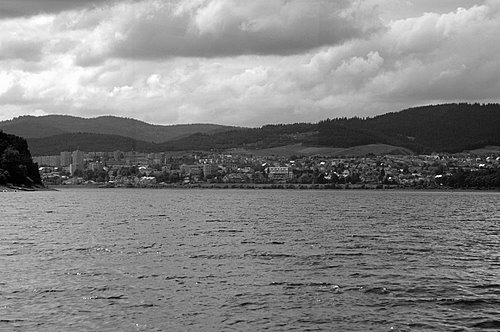
It had always been my understanding that Namestovo more or less was created for the relocation of all those displaced by the creation of the lake. K assures me that it’s not, and there’s no mention of it in Wikipedia. Besides, K made a great point about communist architecture at the time: “Come on — if it had been all built at once, every building would have been identical.”
When we returned to shore, we took a few pictures. It’s fairly obvious the two youngest cousins are getting along swimmingly.
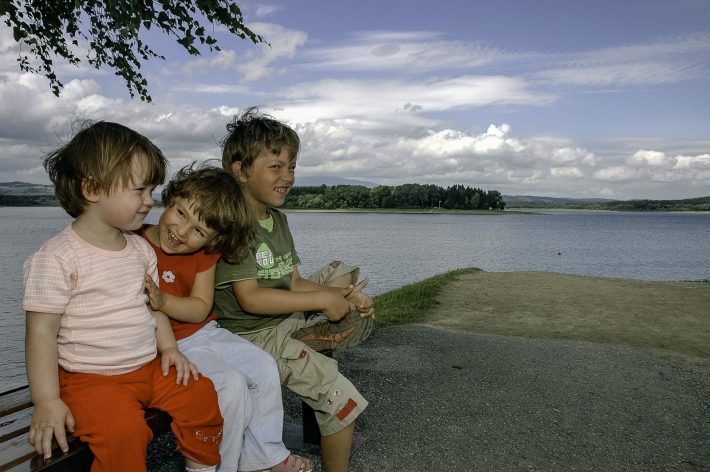
It’s hard to believe that, despite the similarity in size, Cousin S is over a full year older than L. “She’s a brick,” everyone says.
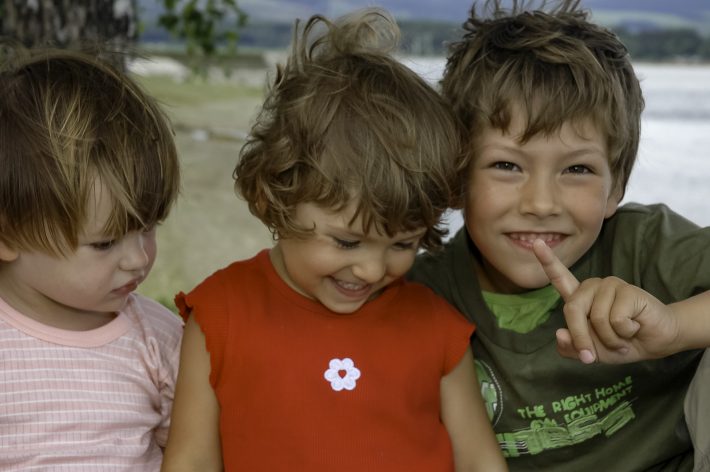
On the way back, we stopped in Bobrov — the Slovakian last town on the Slovakian/Polish border when you cross the border at Winiarczykowka, the small border crossing at Lipnica Wielka.
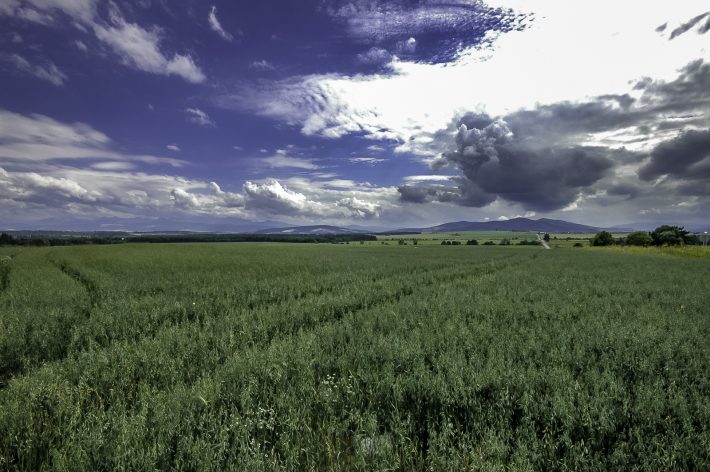
I’d cycled this way countless times when I lived in Poland. Of course, they’ve redone the road in the meantime, which would have made my favorite ride even better: by the time I got to the end of this road on a road bike, I often had to take a break, not because I was tired but because my forearms ached from riding over such a rough road
We also got a clear indication of just how rural this area is:
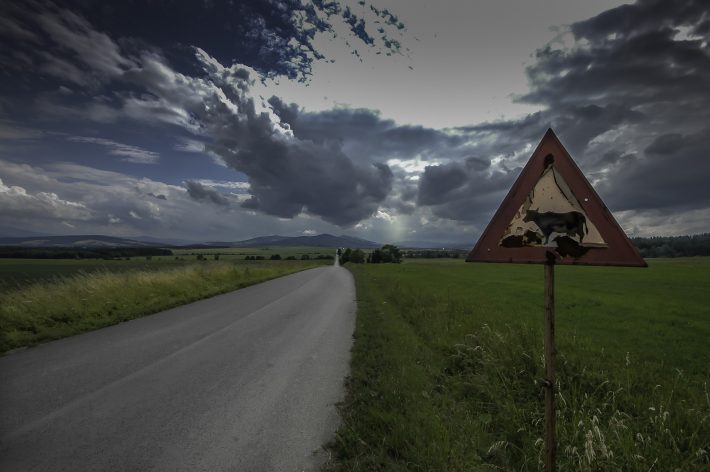
The view from the Polish side of the border wasn’t much different.
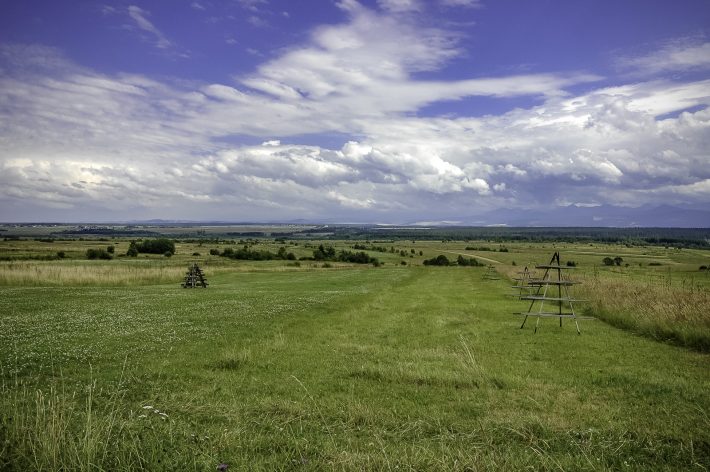
Borders are such strangely arbitrary things. This area is particularly odd. There are masses in Slovakian in the church in Jablonka, yet Slovakian cuisine is really radically different than Polish, even at the borders. The languages are similar (Poles tend to think Slovakian sounds like Polish baby-talk) but the mentalities are different.
When we got home, it was time for the youngest cousins to complete their evening rituals.
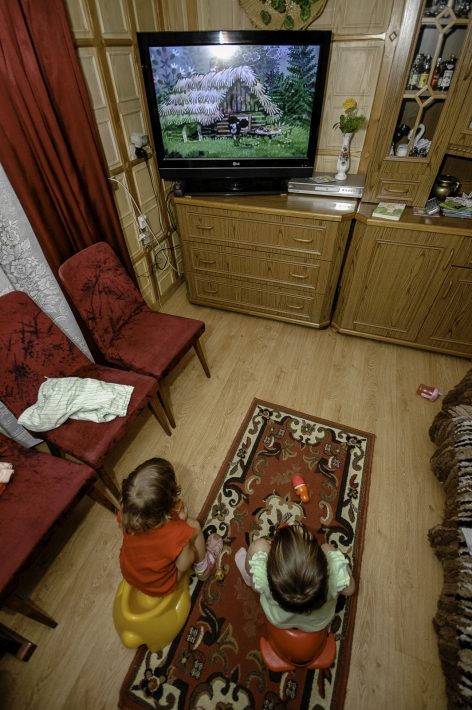
The cartoon they were watching is a Czech cartoon about a little mole who has various adventures with rockets and pregnant rabbits. (He helps birth three rabbits in a rather graphic scene.)
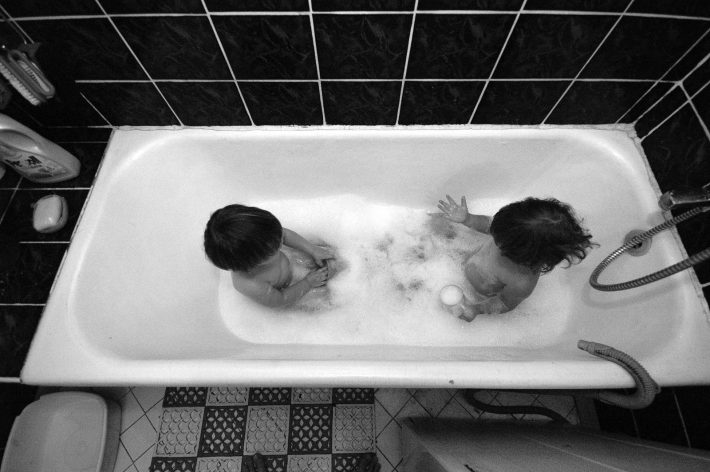
As I said, they’re getting along swimmingly.
Celebration
Saturday afternoon I found myself in a familiar position: a non-Catholic in a place of honor and attention in a Catholic church. With pictures taken beforehand:
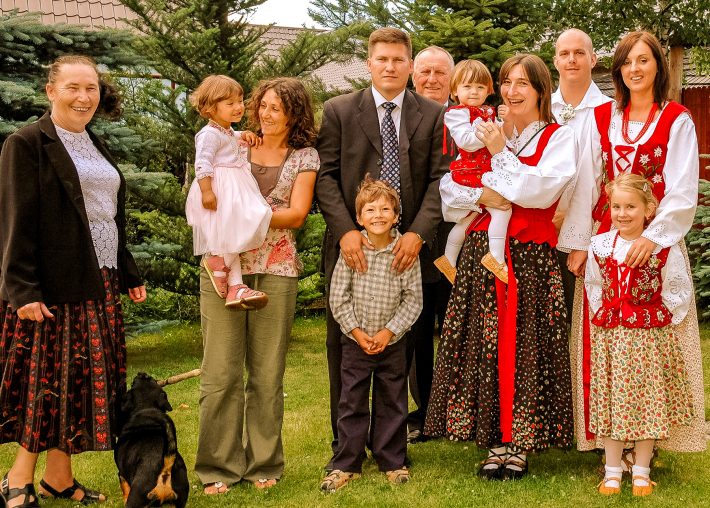
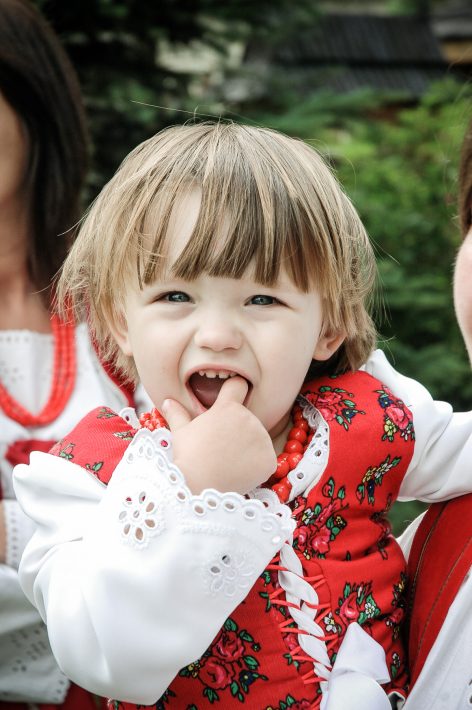
L is now officially Catholic.
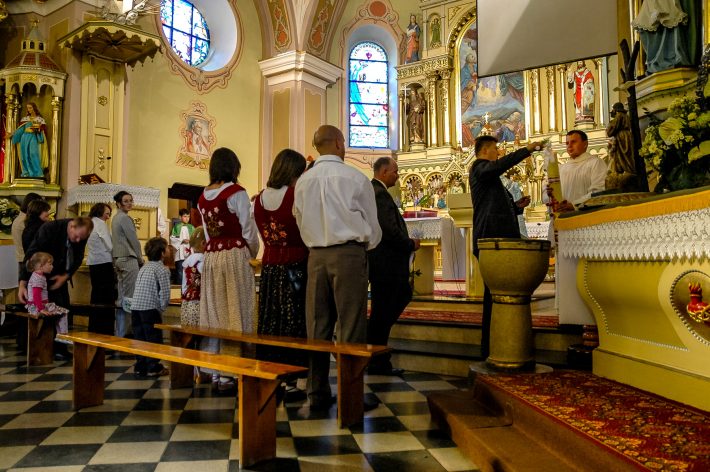
She fell asleep immediately the actual ceremony, much to our relief: she’d begun barking like a dog and begging to get down just before the baptism.
We made a friend before going into the church — an elderly lady whom no one knew but who acted as if she’d known all of us our entire lives.
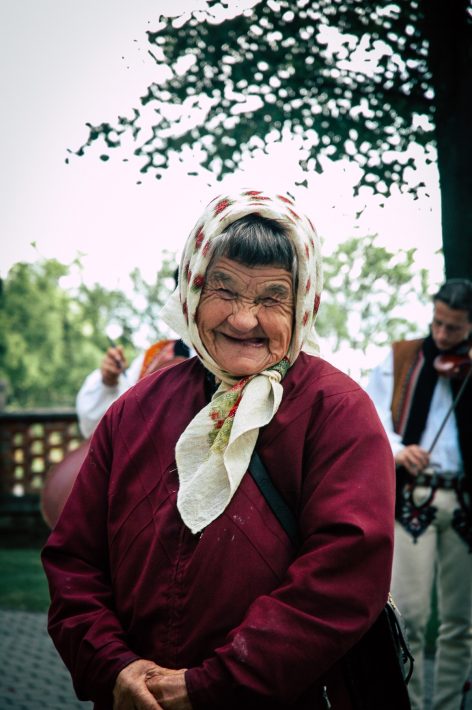
With her speaking the Orawian dialect with a tooth-free mouth, I had no idea what she was saying at any point in the conversation. It was like arriving in Orawa again.
After the baptism, Dziadek took everyone out to dinner.
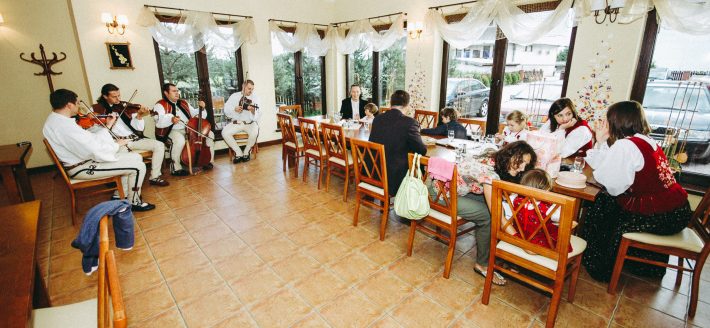
K and L’s godmother, D, danced a little for us.
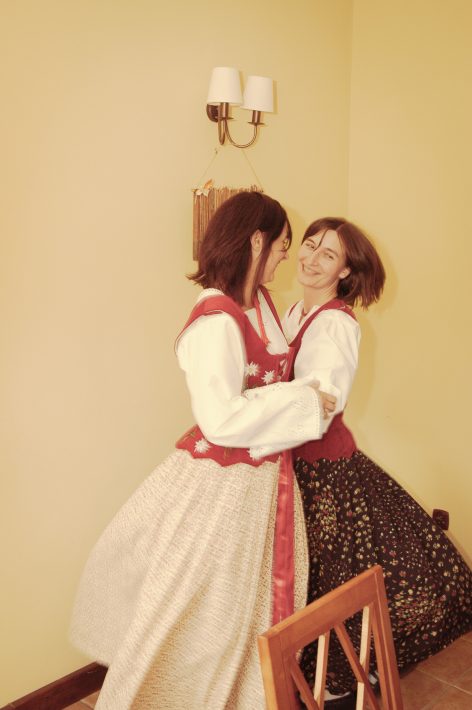
Then it was back to the house a typical Polish evening with family and friends: more food, alcohol, talking, joking.
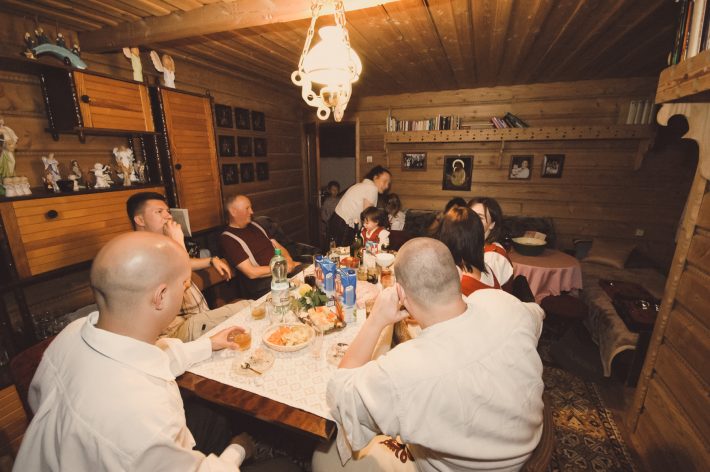
Everyone expresses such surprise when we tell them about teetotalers and the lengths to which some American Christians will go to avoid “sin” (card playing, dancing, etc.). “Poor people,” D’s husband replied. He took it especially hard — he was the designated driver.
An odd thing about Polish designated drivers: while on the whole Poles drink more alcohol than Americans, Polish designated drivers are much more scrupulous about drinking than their American counterparts. I’ve known of many “designated drivers” in America who will drink one small beer, knowing that they’ll still be within the legal limits. Polish designated drivers don’t drink anything. I had to twist G’s arm to get him to take a sip of the whiskey we’d brought Dziadek.
This teetotalism makes even more sense in Slovakia, where to exceed the legal limit, one needs only 0.0001% BAC. In other words, no alcohol in the system at all. Which is good, if you’ve ever seen how Slovaks drive.
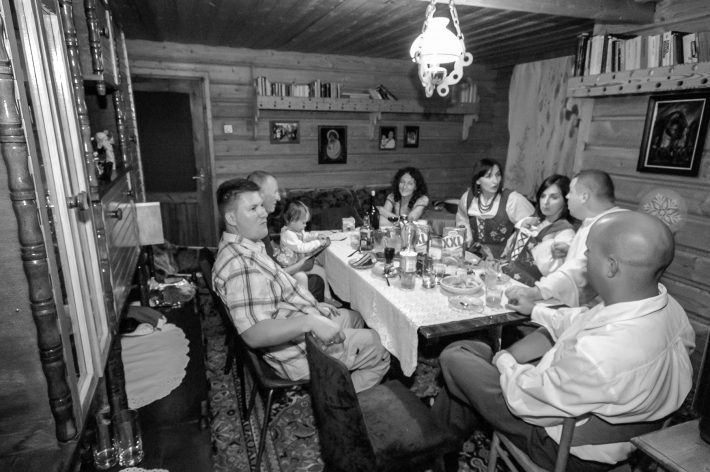
K and the girls in the family insist that we sat talking until 1:30 — not bad for Dziadek and Babcia, who usually go to bed at or before nine.
Next day, more celebrations. We began by playing around in the yard.
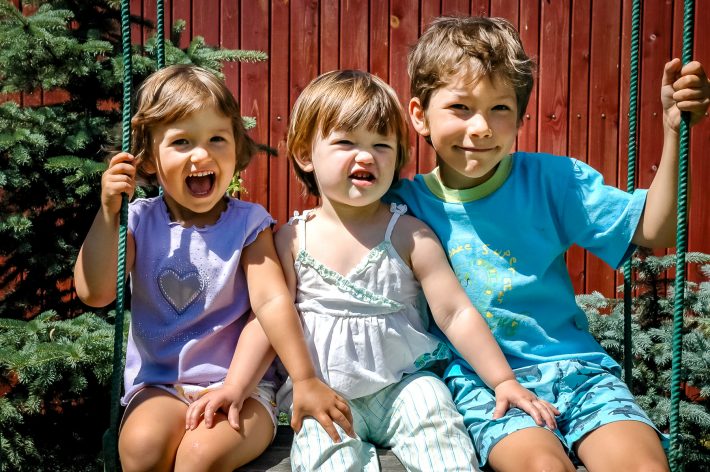
Afterward, we went back to Lipnica for Shepherds’ Holiday — a yearly festival that celebrates regional folk music and culture.
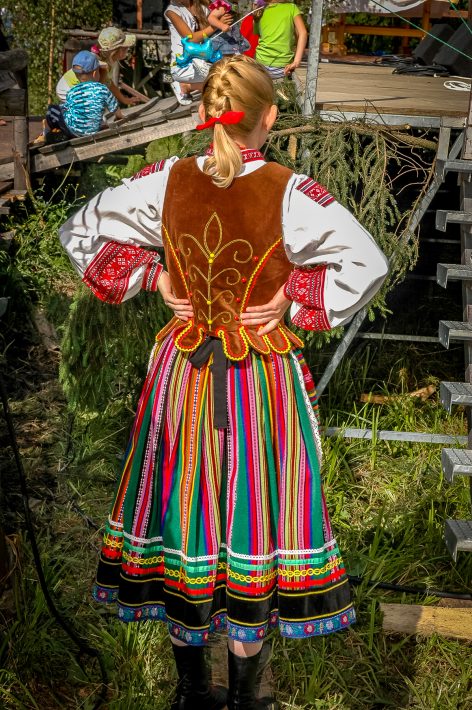
This year it included a mock wedding.
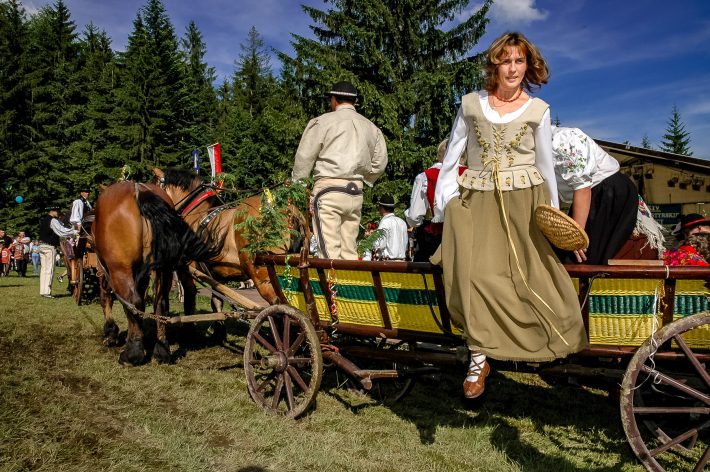
And it ended with a traditional climbing of the May Pole. The safety harness, the emcee explained, was a new addition for EU compliance. Poland is in the EU, and that means certain traditions change — sort of.
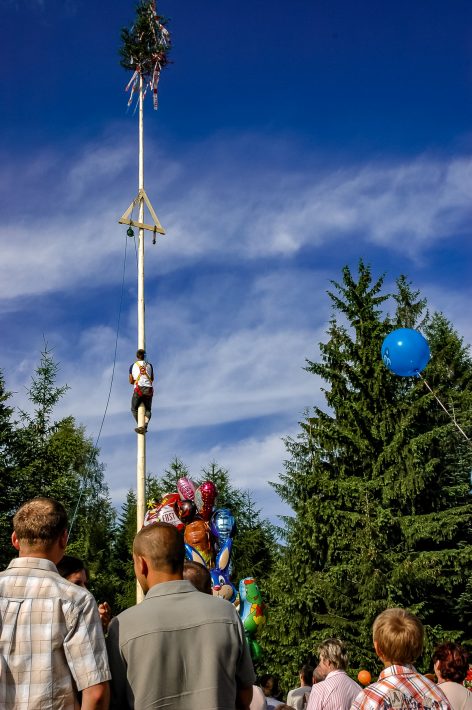
But it wasn’t only for the music I went. I was hoping to meet a few former students and co-workers. I ran into the superintendent of schools and chatted with him for a few moments, and I met a few students. So odd to see them as adults now. One started speaking to me in the familiar voice (“Ty” instead of “Pan”), then stopped short.
“How should I refer to you?” she asked.
“‘Ty’ is fine,” I replied. “It makes me feel less old than ‘pan.'”
Another explained that he was working in Denmark.
“How’s your Danish?” I asked.
“I don’t speak a word of Danish!” he laughed. “I use the English you taught me.” He used “pan,” but he was always a very respectful young man.
It’s rewarding to know that something I did is having such far-reaching effects. I almost told the young man — who, despite being polite, was something of a slacker — “I’ll bet you wish you’d done your homework more often,” but he might have taken it seriously.
We left around 6:00, when the girl was growing tired, not to mention her parents. We walked back down the parking lot — undoubtedly the most beautiful parking lot I’ve ever seen.
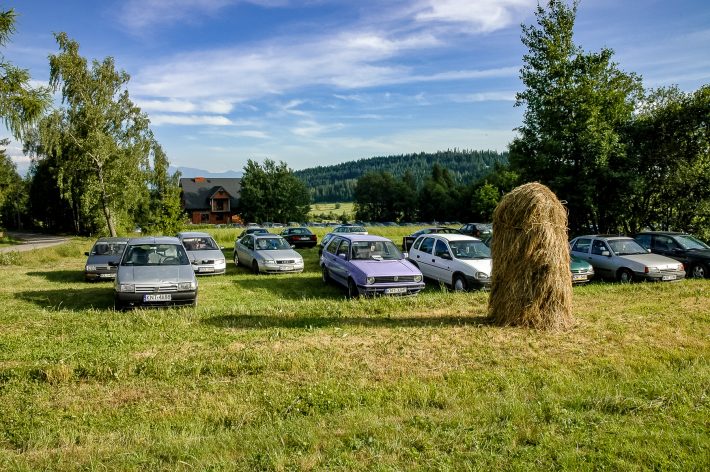
We returned home and returned to our front-yard games.
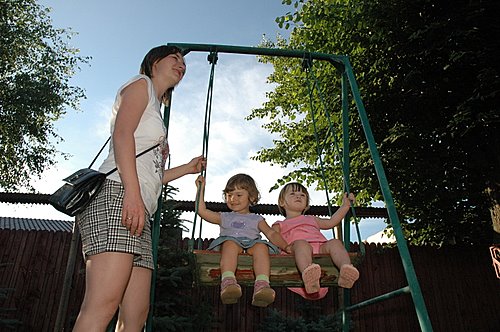
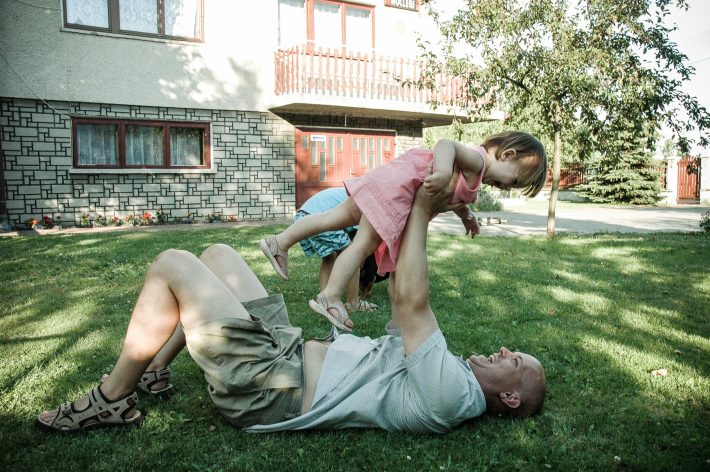
It was about this time, when the sun was casting long shadows and giving everything a golden glow, that Babcia suggested we take the kids for a walk.
“Maybe they’ll get to see some cows,” she said.
There were no cows, but the light was incredible.
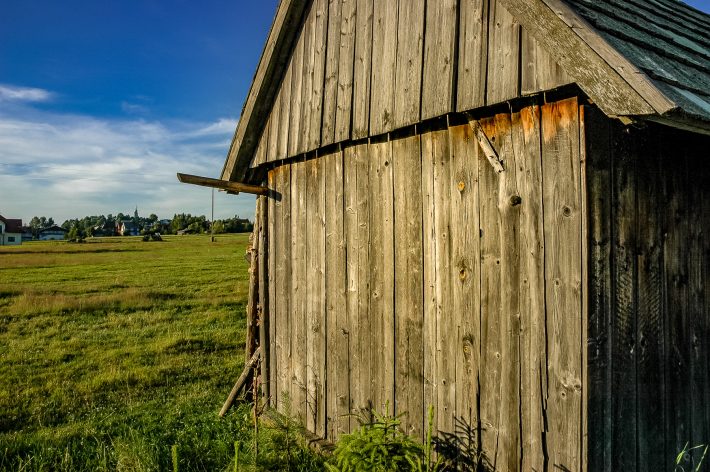
I went ahead and took a few pictures.
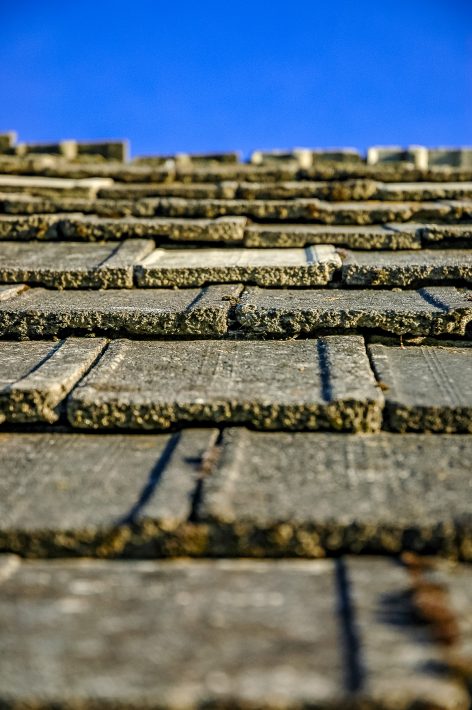
Then K and L came running at me.
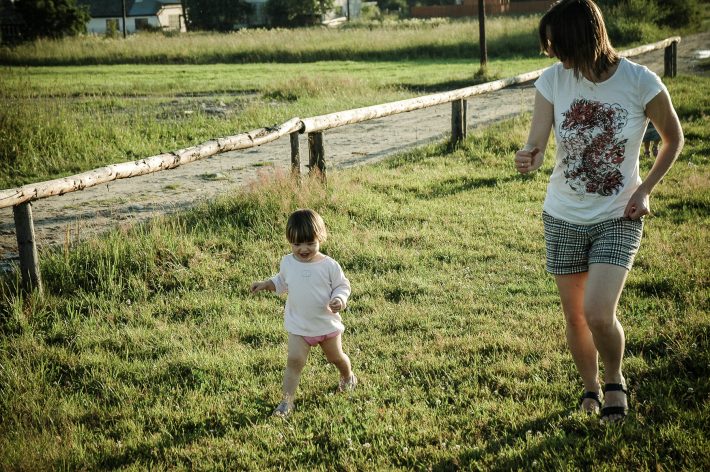
We took the kids to a field with freshly-mowed hay and tried to take some candid portraits.
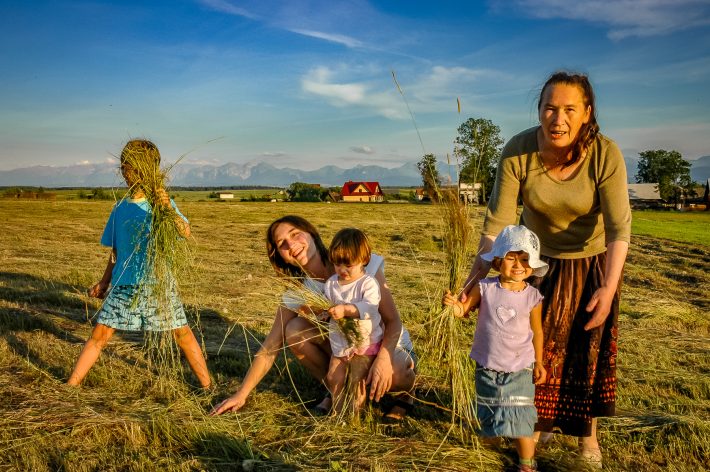
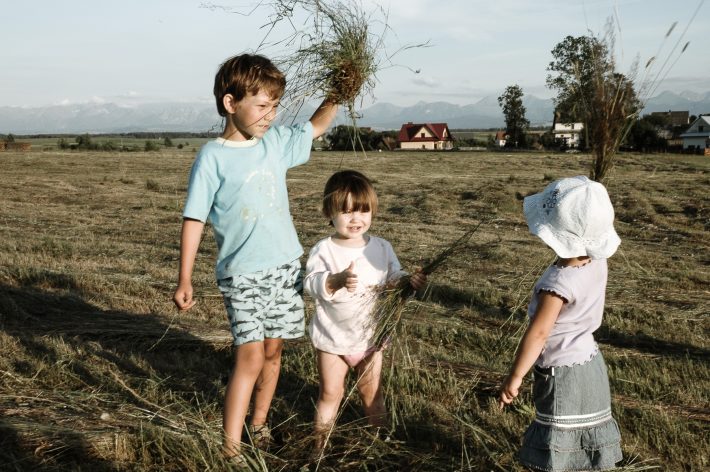
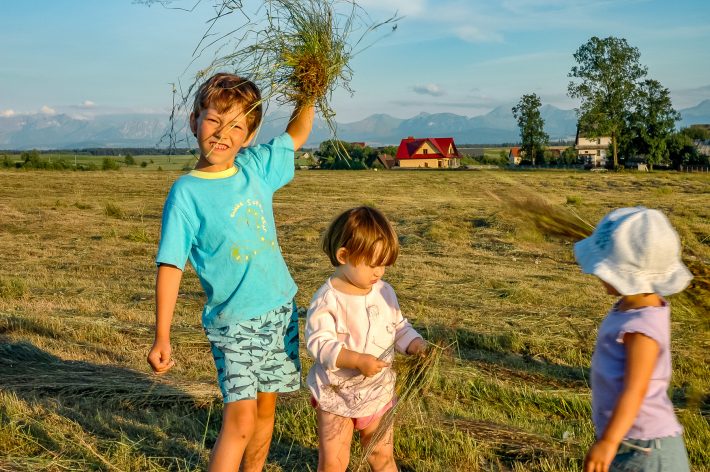
With the Tatra Mountains in the background and the children’s laughter, it was difficult to imagine a more idyllic setting.
Who couldn’t sit and look at a view like this for hours daily:
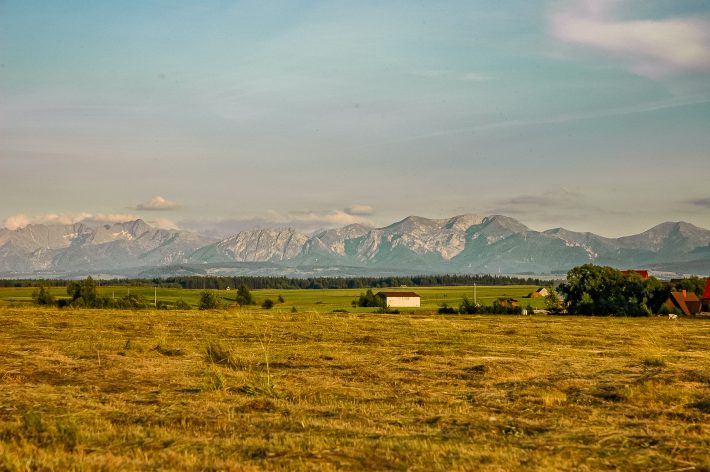
On the way back, our freshly Catholicized little girl got sleepy.

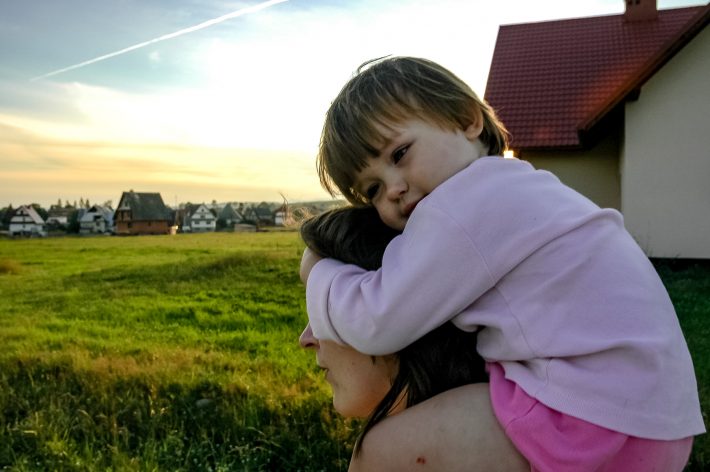
We stopped at a little neighborhood chapel on the way back.
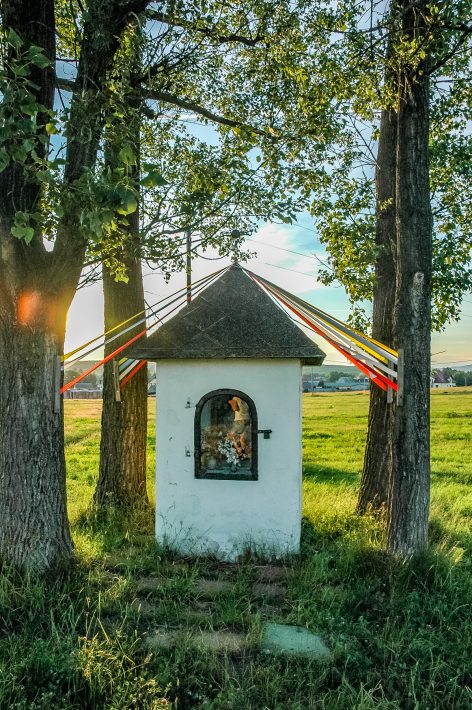
During summer evenings local residents meet at the small chapel to pray.
It also provided a depressing reminder of how Poland is changing. Scratched into the side of the chapel were two common examples of Polish profanity. (I won’t provide a translation. If you know someone who speaks Polish what it means, they’ll probably tell you. Hesitantly, if they’re from an older generation.)
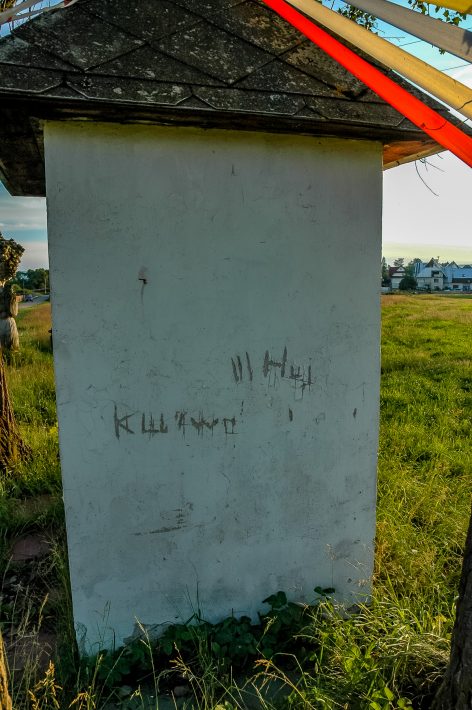
It seemed profane in the truest sense of the word’s meaning. Childish curse words scratched on an object held sacred by many.
Finally, a different kind of sacred:
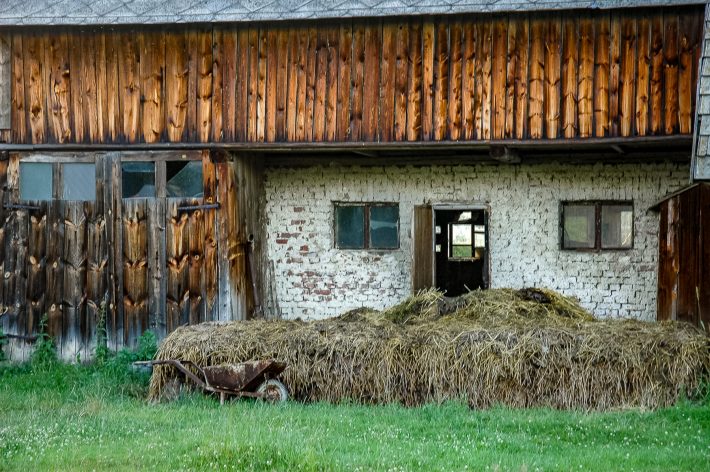
That pretty much covers Saturday and Sunday. Today — well, I’ll put that off a little bit and return to more important matters here at hand.
